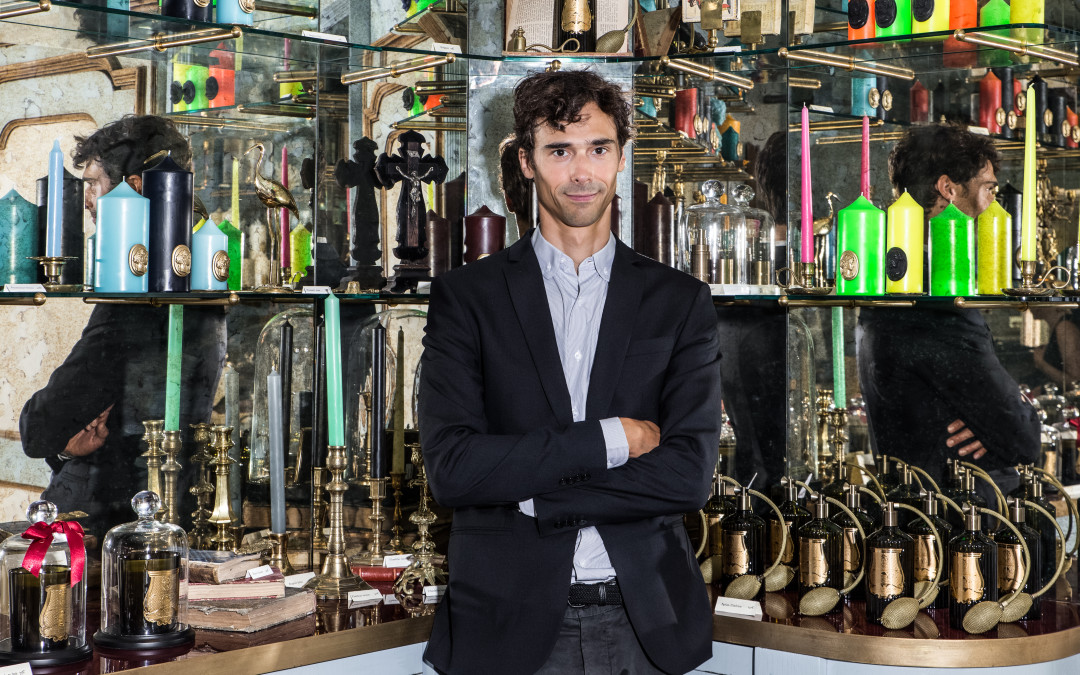
by Rebecca Taras | Feb 28, 2019 | Candles, History, Home, Paris
If you’ve ever visited the Palace of Versailles, then you’re well aware of its magnitude in both size and stature. Even if you haven’t, the numbers speak for themselves: Imagine 700 rooms, more than 2,000 windows, 1,250 chimneys, 67 staircases, and a capacity for 20,000 people. As long as we’re talking stats, equally astonishing is the 3,000-plus candles that illuminated the palace—out of necessity, not a craving for ambiance.
But indispensability is what ultimately laid the groundwork for the Trudon family legacy. In 1643, Claude Trudon opened a boutique on rue Saint-Honoré that specialized in candles, among other provisions. It wasn’t long before the court of Louis XV and the kingdom’s most commanding parishes were demanding the pristine white beeswax candles. In 1737, Claude Trudon’s descendant, Jérôme Trudon, purchased the Manufacture Royale des Cires (a.k.a. Royal Wax Manufacturer) in Antony, France from Péan Seigneur Saint-Gilles, expanding the firm’s capabilities.
To learn more about the rich history of this fascinating luxury candle company, I strolled over to the Cire Trudon offices at Place des Victoires to meet with Julien Pruvost, executive director for the brand. Among other things, we discussed how the Trudon family formula wound up in the French encyclopedia (encyclopédie, ou dictionnaire raisonné des sciences, des arts et des métiers), his favorite Trudon company legend and how the brand survived into the modern-day world.
With a view of the Basilica of Notre-Dame des Victoires from the office window and the intoxicating aroma of Trudon candles in the air, it wasn’t hard to imagine a time when all the world was bathed in the incandescent glow of candle light.

Photo courtesy of Cire Trudon.
In your own words, describe the history of Cire Trudon. “The history of Cire Trudon is short. The brand [as you know it now] was born in 2005. We cannot speak of a notion of brand survival, nor of survival here. The point is about transmitting, protecting and developing know-how. Cire Trudon condenses all of this into one entity. Cire Trudon tells the true story of over 350 years of candle and wax knowledge. Through its art, Cire Trudon tells the story of a people, a country, while speaking to the modern world.”
“I think that the main focal point is that we’re speaking to the former Royal Wax Manufacturer. When the Trudon family purchased the company from the former manufacturer, it had only recently become a thriving business that catered to the royals. They also improved the quality of the product to the point that a whole section of the French encyclopedia on arts, sciences and crafts is based on Trudon know-how. The engineer who was in charge of that section went to the Royal Wax Manufacturer and wrote down everything you would ever need to know about candle manufacturing—you could literally relaunch a candle produced in the way that it was done in the 18th century.”
What has enabled the brand to survive—and thrive—for so many years? “We don’t really consider ourselves ‘survivors;’ rather, we consider ourselves carriers of the heritage. We were able to reinvent ourselves. In a way, the Trudon family reinvented themselves when they improved the manufacturing from the previous [Royal Wax Manufacturer] owner. They were able to adapt the business to a time when gas and electricity were making their appearance. As for today, we’re not here to light a home—but we are in the decorative realm still producing candles, so that’s the important point.”
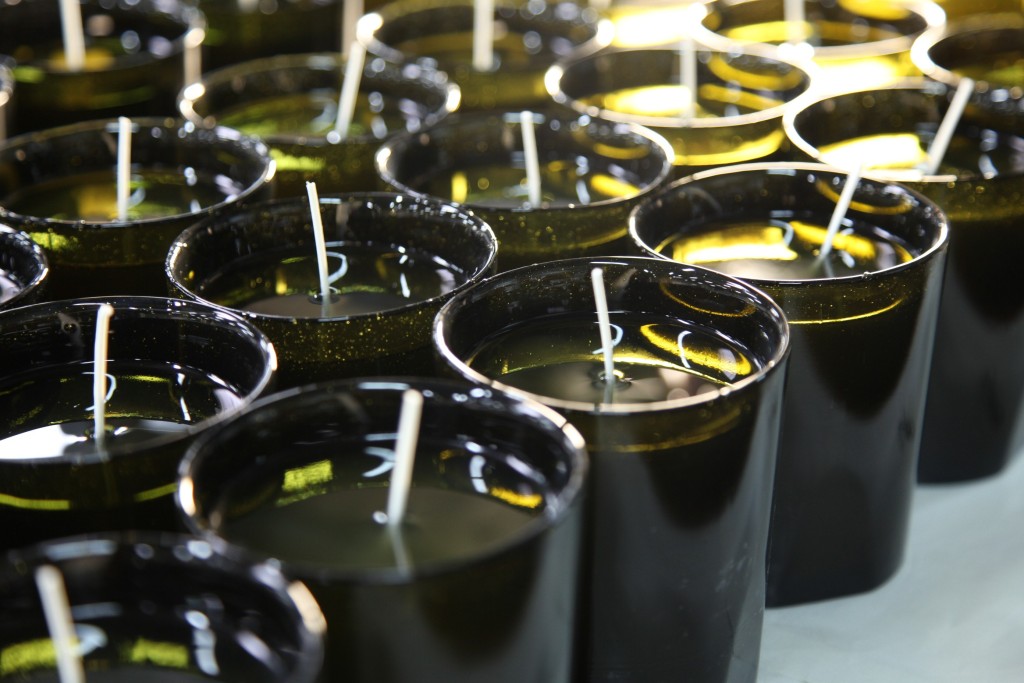
Photo courtesy of Cire Trudon.
Since the candles were originally a home necessity versus a decorative item, when was the fragrance introduced? “I found a late record of a lavender and citronella candle produced by the Trudon company—but later, in the early 19th century. We know for a fact that Paris was not the cleanest place on earth back then, and malaria was around, so you needed all sorts of propellants. Citronella candles—which we still use today—were used to keep the inside air purified. The homes were not that clean, so we assume that lavender candles were mainly around to purify—not scent—the room. It was a modern invention.”
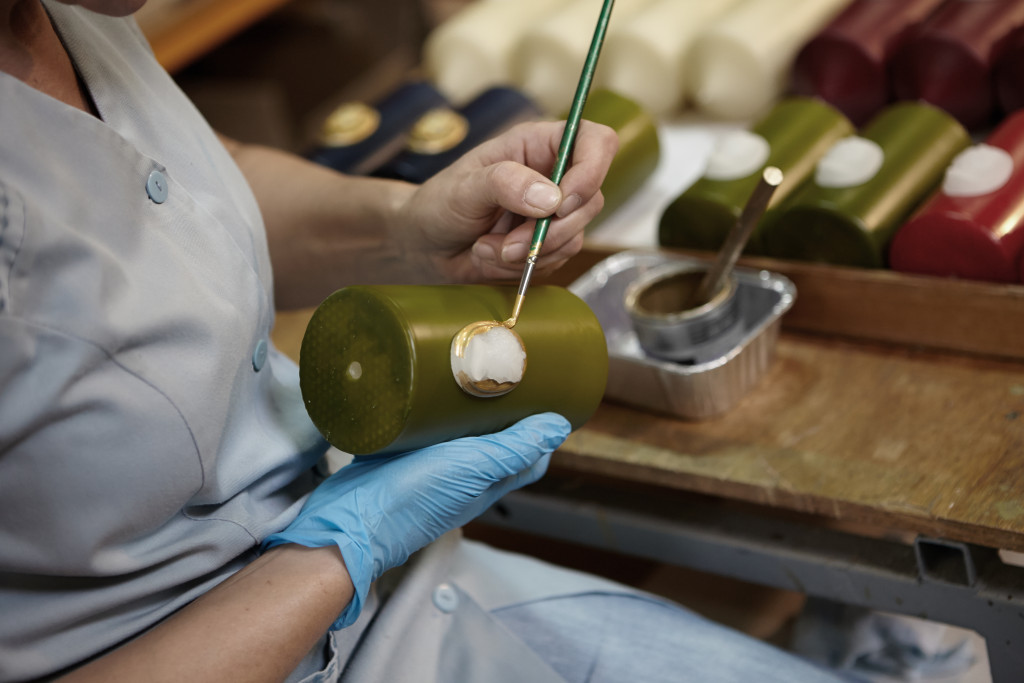
Photo courtesy of Cire Trudon.
When a company has been around for so long, there are generally a few great stories from its past—what is one of your favorite Cire Trudon legends? “My favorite legend is about the tunnel that might have existed between the Louvre and the Trudon store that used to be right behind the Louvre castle on Rue de l’Arbre Sec. Since Paris had an amazing tunnel grid beneath its surface that was exploited all through the Second World War, essentially for commercial purposes, it was very plausible that a tunnel existed between the Louvre and the Trudon store. The tunnel grid goes back to the Roman period when rocks were carved out of the Paris rock-bed. The grid served many purposes over the centuries, from simple rock source to catacombs to bomb shelters, etc. So legend has it that there was a horse carriage that brought the goods back and forth.”
What makes a Cire Trudon candle so special? “A candle is meant to melt. If the surface of your candle isn’t completely molten, then the scent won’t be released. It’s also important for the candle to overburn. You need to adapt the wick to the the fragrance. Some will encourage the burn, while others with larger fragrance molecules inhibit it. Each of our 100% cotton wicks is specifically calibrated for each scent. Other features include: Non-drip, don’t omit smoke, complex and highly sophisticated fragrance compositions, and unique natural beeswax formula.”
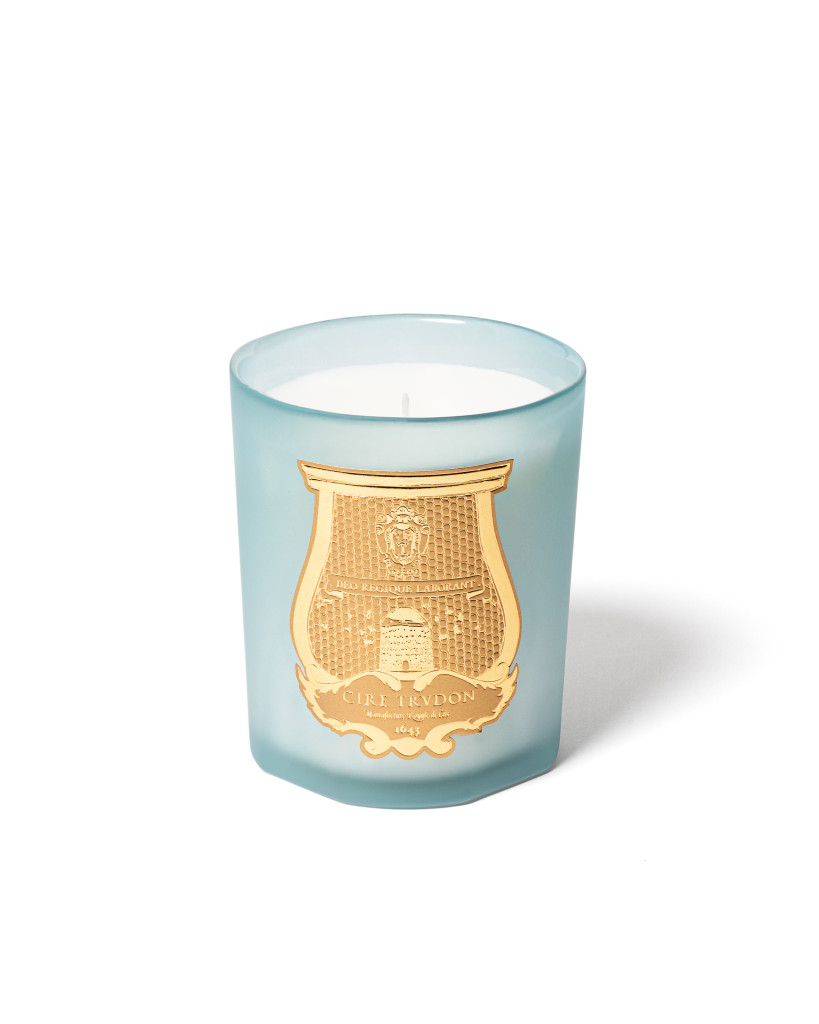
Photo courtesy of Cire Trudon.
How do you go about creating the scents? “We have an in-house team that comes up with the types of notes we would like to associate with each theme. For example, from a historical theme like Josephine. We looked at a certain part of her life when she lived in the Château de Malmaison after divorcing Napoleon. She loved tending to her rose garden and was fascinated by birds and plants, so it was very easy to work with that in terms of developing notes. Next, we bring the idea/concept to one of our perfumers.”
How long does it take to develop a scent? “We were never able to develop anything in under six months. However, when a scent comes out of the lab, it will not smell the same weeks down the line. The more you let it settle, the closer it will be to what the end result is. You cannot rush this process. It needs to mature because we try to work with the maximum amount of natural ingredients. They’re rounder, deeper and more interesting—these types of raw materials need to mature.”
What are the essential oils/fragrances you use? “They come from around the world, including France, and are transformed in Grasse, France.”
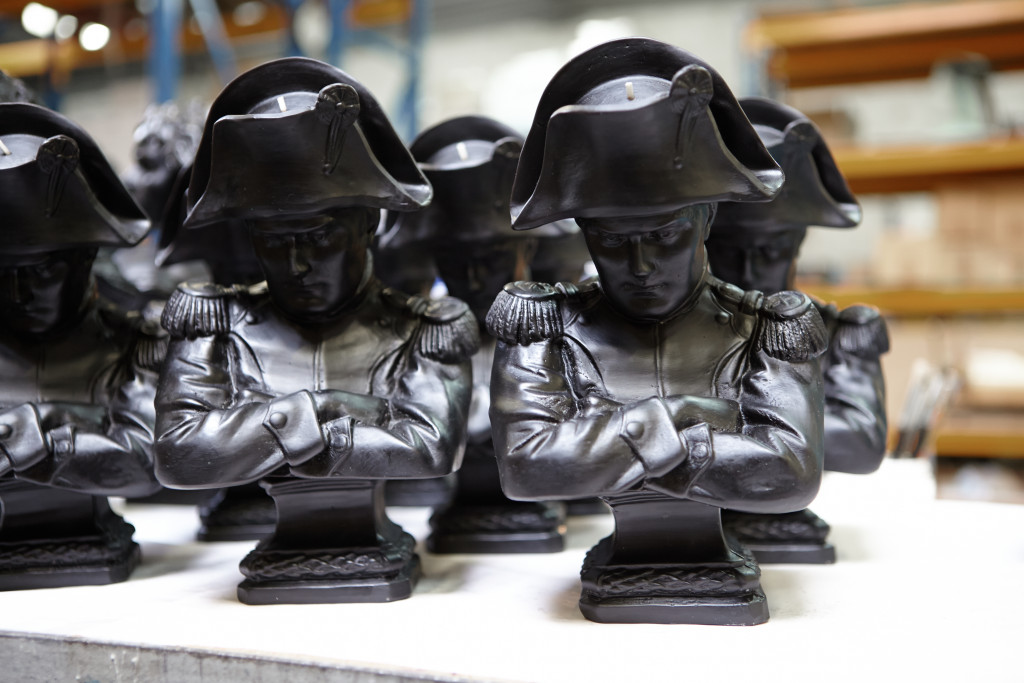
Photo courtesy of Cire Trudon.
Tell me about a few of your favorite offerings, past and present. “I personally use these days Bartolomé, Madeleine and Positano. I also use a lot the Cire Trudon travel room sprays—especially in my car or when I am travelling extensively. Watching our wax busts being made is also fascinating. We have a partnership with the French National Museum Council to have the exclusive rights to reproduce in wax certain references in their catalogue.”
How did you get involved in this business and what do you love about it? “I joined the company as head of private label in 2009. I slowly got involved in the manufacturing part of the business, and that’s when I really fell in love with the company. For me, it’s very grounding to know that there’s a place where I can go and see the products that we’re offering while working on ways to constantly improve them. I also love the fact that we are selling an ancient product into our modern, high-speed world.”
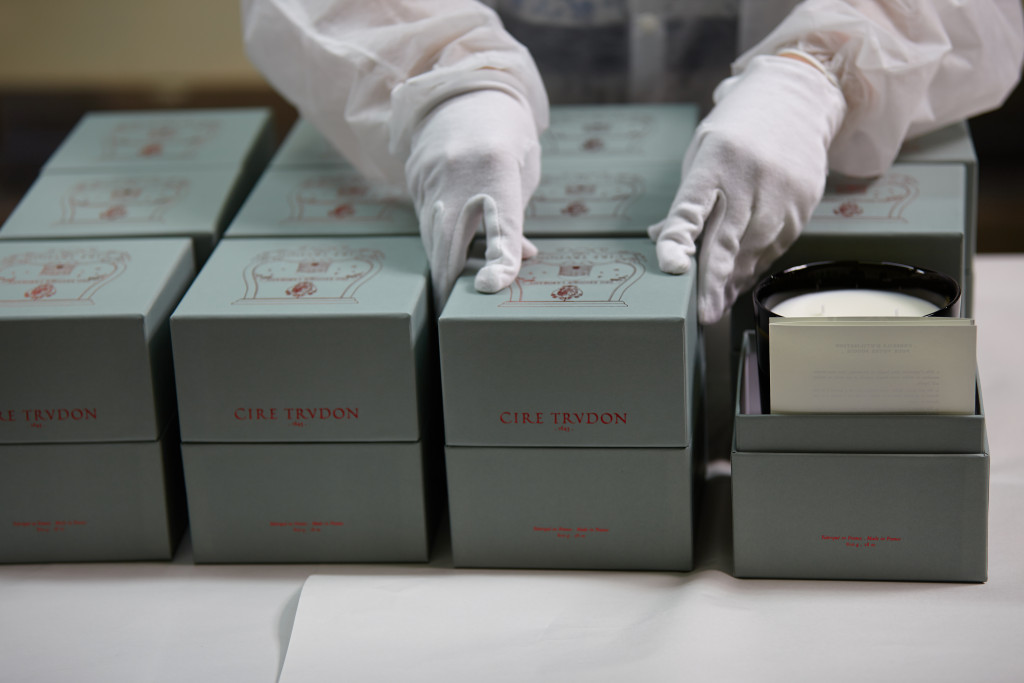
Photo courtesy of Cire Trudon.
Why do you think France has had so much success in creating luxury products over the years? “During the mid-17th century under Louis XIV, France made the market luxurious. Everything came from France and everyone wanted things from France, whether it was perfume, furniture, clothing—even architects, gardeners and scientists. Everything had been promoted so intensively under Louis XIV that there were thriving companies in France making all sorts of things. In a way, France is still living up to that, though it obviously had to adapt.”
WTB Signature Questions:
What do you always have in your carry-on bag? “For the last year and a half I have been carrying around fragrance samples with me. I try to smell a single fragrance in a variety of environments and situations. The home and/or the office are not always the best places to evaluate a fragrance because you’re used to their scent/environment.”
What is one of your favorite travel destinations and what is a destination on your bucket list?
Favorite destination: Lanzarote Island “It’s part of the Canary Islands. One, there is fantastic surfing over there and two, it’s a very wild and untapped place. Even so, the mayor of the main town is a man called César Manrique; he is also an artist, so he built a variety of structures on the island that are simply amazing. They’re built in lava tunnels or fields, so there’s a combination of this really rough landscape and modernist architecture. It’s like nothing that I’ve seen elsewhere.”
Bucket list destination: The Roden Crater (Arizona) by James Turrell “James Turrell is an American land artist who bought a crater in Arizona and turned it into an experimental art piece that you can actually penetrate and walk around. It relates to the sky and the stars, and it’s a real experience, from what I heard.”
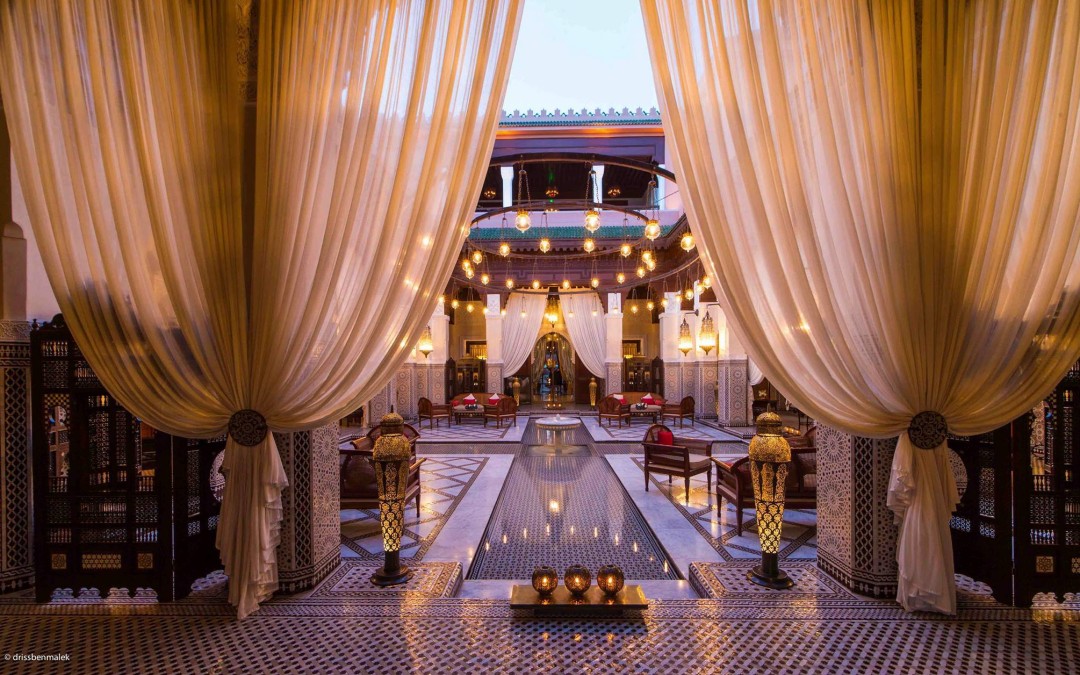
by Rebecca Taras | Feb 17, 2019 | Home, Hotels, Luxury
For most of us, taking a vacation requires strategic planning, to include saving enough dough to make the whole experience worthwhile without having to come home empty-handed with your pockets turned inside out like the Monopoly Man.
After all, how many times have you tried to rationalize your lodging choice by saying something like, “but how much time are we really going to spend in the room, anyways?”
That’s all well and good, but if you had the opportunity (and the cash flow) to stay in one of the following plush pads, we have a feeling sightseeing might become a second-tier activity. From a property owned by a king to an entertainment area with 1,000-plus books to inhabitable art (yes, really), you’re going to wish you could check-in indefinitely. Suite dreams, dear reader.
Majestic Hotel: Sagrada Familia Penthouse

Photo courtesy of Majestic Hotel & Spa.
While you can explore an entire city and all of its historical monuments by foot, there’s something to be said for being able to take in the sights while lying in bed or sitting on the couch reading the morning paper. All is possible at the luxurious, five-star Majestic Hotel in Barcelona, which boasts a bevy of modern-day conveniences, within ancient environs, located on the Paseo de Gracia, one of the most celebrated avenues in in the city.
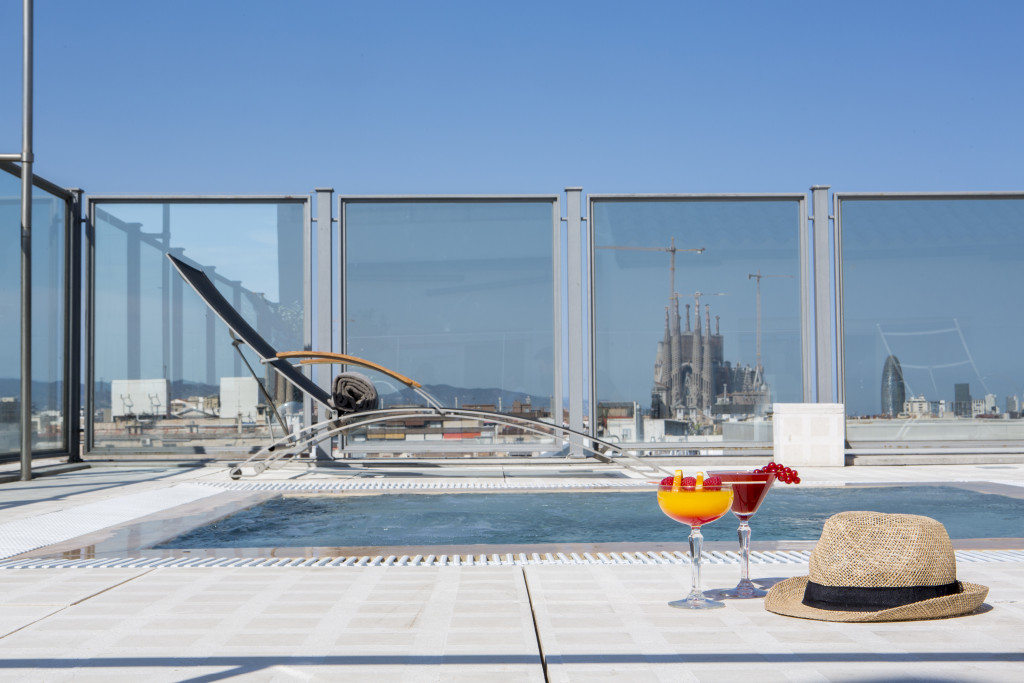
Photo courtesy of Majestic Hotel & Spa.
As one would guess, the Sagrada Familia Penthouse boasts spectacular views of the temple with the same namesake from the sprawling terrace, complete with pool. As if that wasn’t enough to bait you in, this ninth floor respite was named one of the best suites in Spain by the World Travel Awards. Rates start at approximately $2,639.
Majestic Hotel Barcelona, Passeig de Gràcia 68-70 (Barcelona, Spain); +34 93 488 17 17.
Park Hyatt Tokyo: Tokyo Suite
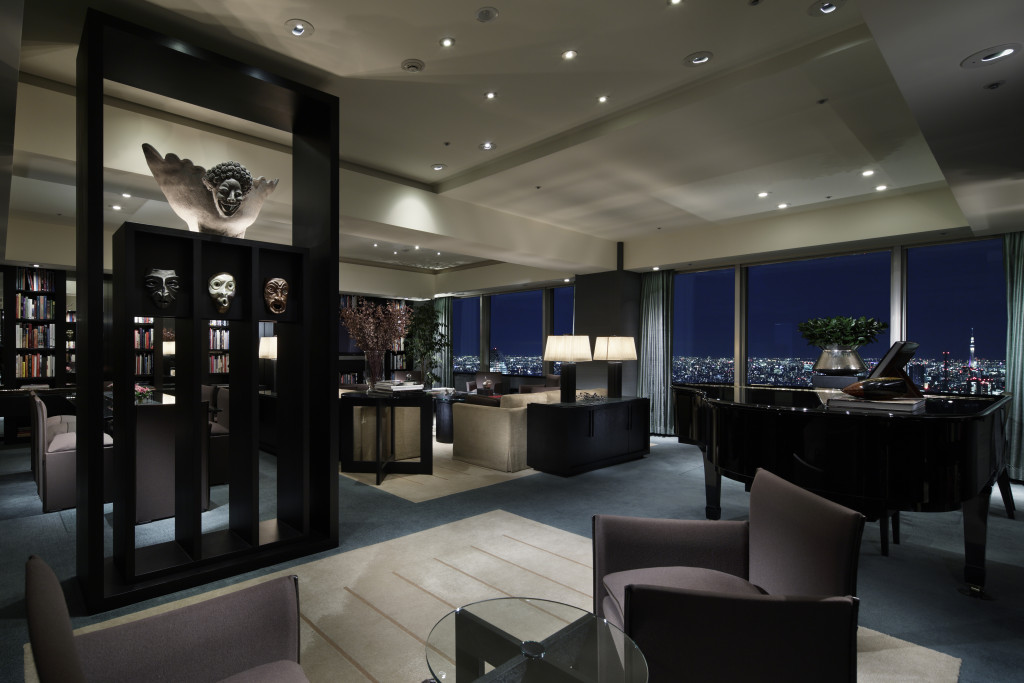
Photo courtesy of the Park Hyatt Tokyo.
The city may be bustling, but it’s nothing but serenity within the palatial environs of the Park Hyatt Tokyo, located on the top floors of a towering skyscraper in one of the most vibrant cities in the world. While the views are unparalleled from any vantage point in this sky-high paradise, it’s the scenery within the Tokyo Suite on the 50th floor that rivals anything on the other side of the glass.
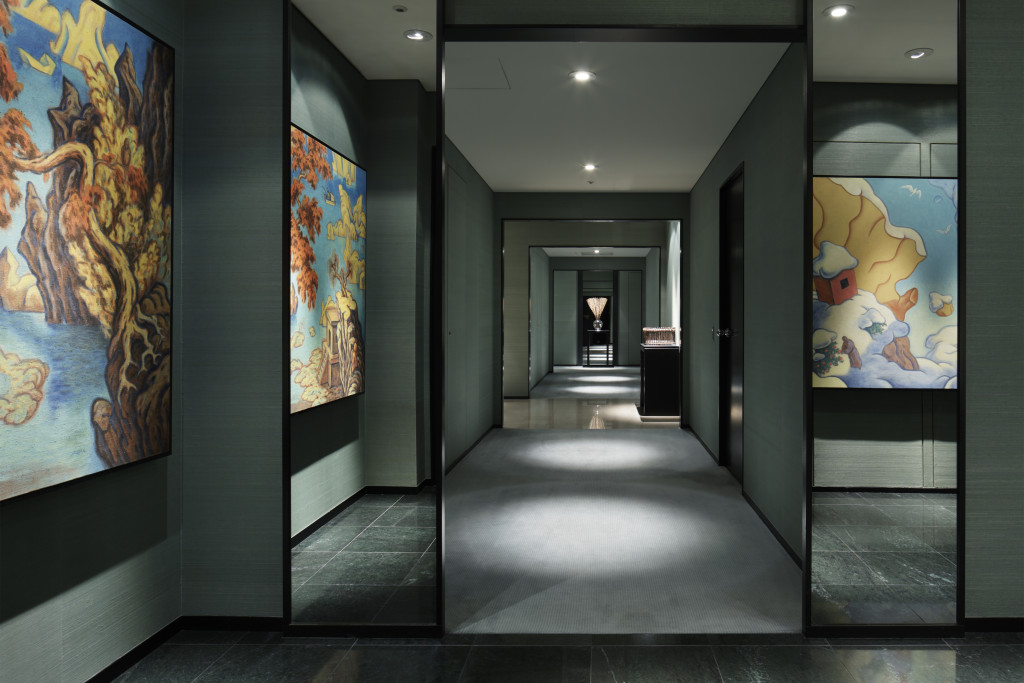
Photo courtesy of the Park Hyatt Tokyo.
The impressive suite is a dream come true—particularly for anyone with a cultural bone in his or her body. Over 1,000 books and monographs beckon casual and hardcore readers alike, and the amount of impressive artwork on display rivals the galleries of some of the worlds’ greatest museums. Rates start at approximately $5,496.65.
Park Hyatt Tokyo, 3-7-1-2 Nishi Shinjuku (Shinjuku-Ku Tokyo, Japan); +81 3 5322 1234.
Royal Mansour: Riads
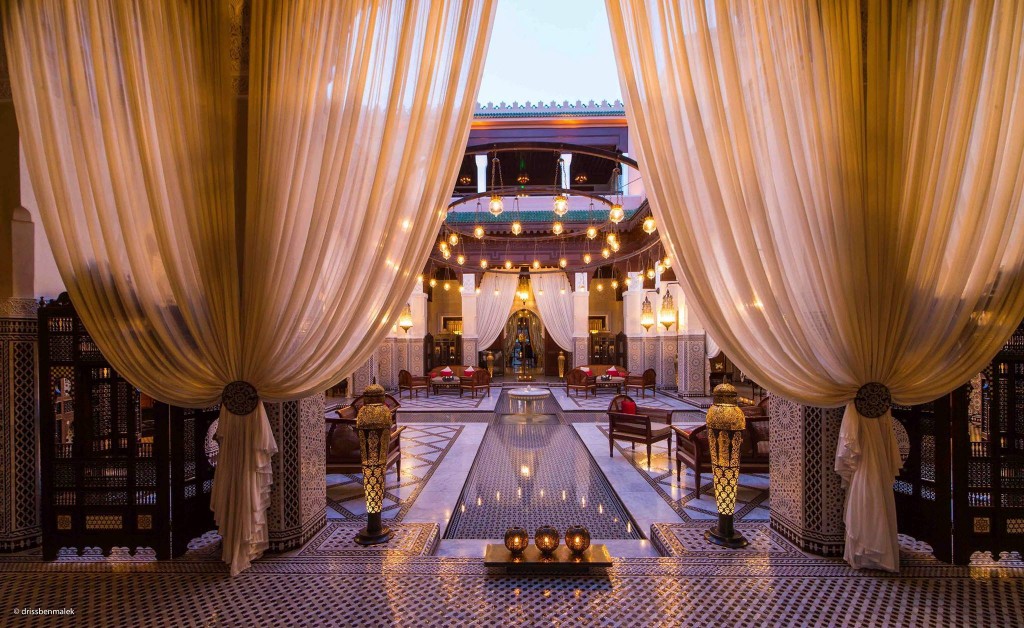
Photo courtesy of Royal Mansour.
It’s no surprise that this Marrakech property has palace-like characteristics, as the current King of Morocco, Mohammed VI, owns it. In fact, a “riad” is a traditional Moroccan house or palace with an interior garden or courtyard. The word stems from the Arabian term for garden, “ryad”—an architectural gem that was introduced during the rule of the Idrisid Dynasty.
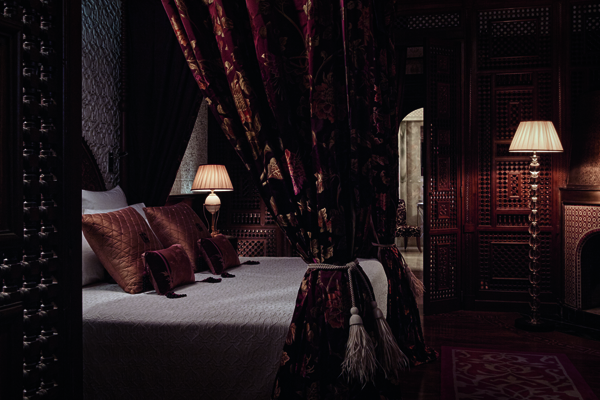
Photo courtesy of Royal Mansour.
The riads—available with one-to-three bedrooms—each have their own rooftop plunge pool to cool off from the desert sun, traditional (read: stunning) Moroccan décor and enough mysterious nooks and crannies to feel like an Indiana Jones movie—even the staff travels by a series of tunnels through service entrances, thus keeping the experience private. The only thing missing? A magic carpet—but we haven’t given up hope yet. Rates start at $1,175 for a one-bedroom riad.
Royal Mansour Marrakech, Rue Abou Abbas El Sebti (Marrakech, Morocco); + 212 5 29 80 80 80.
The Beaumont: ROOM

Photo courtesy of The Beaumont.
This intimate Art-Deco-inspired boutique hotel is the brainchild of restaurateurs Corbin & King, responsible for The Wolseley, The Delanay and several other highly esteemed eateries in London. Among the 50 rooms, 13 studios and 10 suites, the pièce derésistance is ROOM, an inhabitable sculpture commissioned from Turner Prize-winning British artist Antony Gormley. Can’t afford to stay in ROOM? You can get a peek at what the structure looks like from the exterior, as it clings to the façade of the hotel.
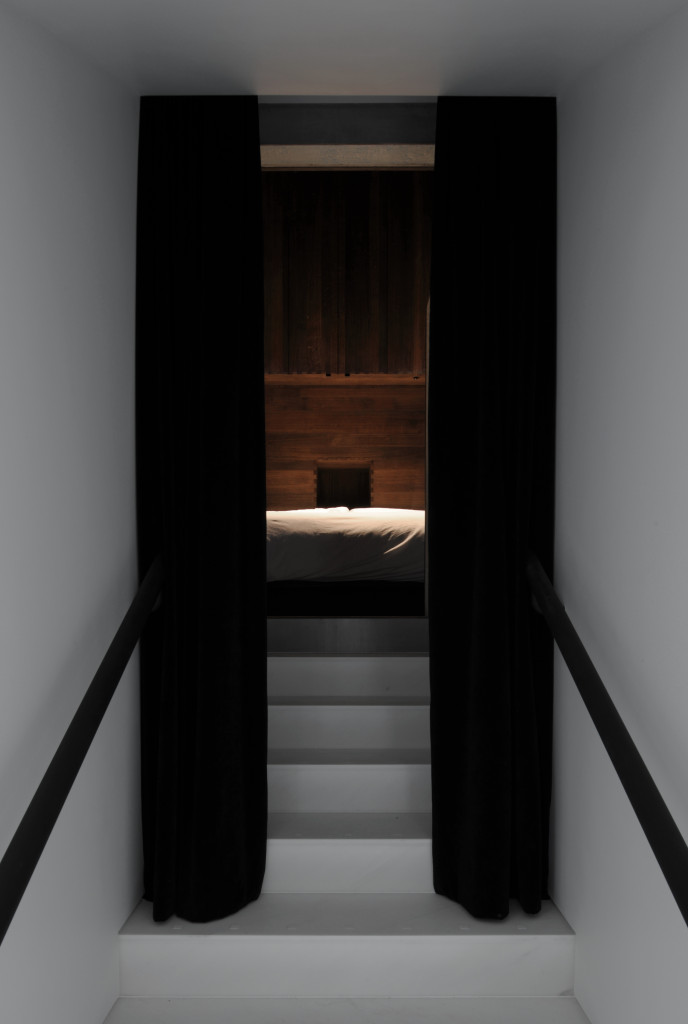
Photo courtesy of The Beaumont.
Gormley’s version of “sculpting darkness” translated into a cave-like space that encourages guests to enter a different state of consciousness—in other words, to really chill out for a while. The rest of the one-bedroom suite is decorated in true Beaumont fashion, complete with vintage art and photography books and Art Deco nuances throughout. Rates start at approximately $3,370.
The Beaumont, 8 Balderton Street (London, United Kingdom);
+44 20 7499 1001.
Metropolitan by COMO Miami Beach: COMO Suite
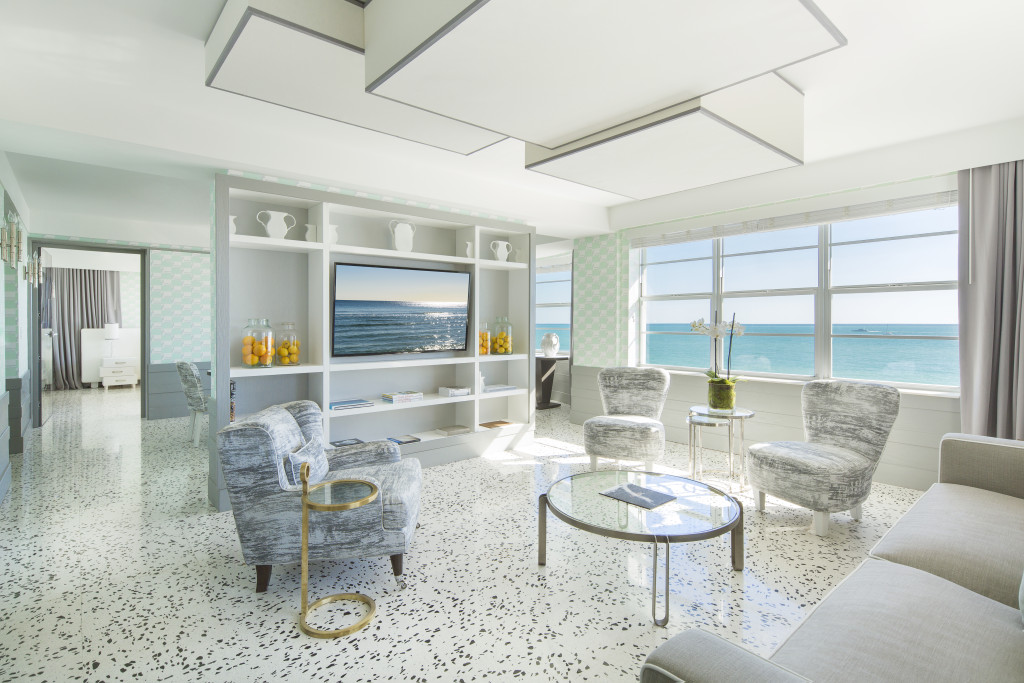
Photo courtesy of Metropolitan by Como.
Location, location, location. You don’t need to travel to the ends of the earth to get a room with a view when Miami Beach is just a short plane ride away. This boutique Art Deco style hotel is in the heart of it all—shopping, dining and entertainment—but if you want to avoid the crowds, there’s a frosty libation waiting for you on the terrace of this posh pad.

Photo Courtesy of Metropolitan by Como.
The Como Penthouse Suite features sweeping views of the Atlantic from every room, so it feels as though you’re on the beach—but without having to worry about getting any sand in your shoes. Those traveling with multiple houseguests have the option to connect with two-to-three additional bedrooms, and the corridor can be secured to create a private “wing-like” feel. Rates start at approximately $1,415.
(CS 1 PIC)
Metropolitan by COMO Miami Beach, 2445 Collins Avenue (Miami Beach, Florida); 305-695-3600.
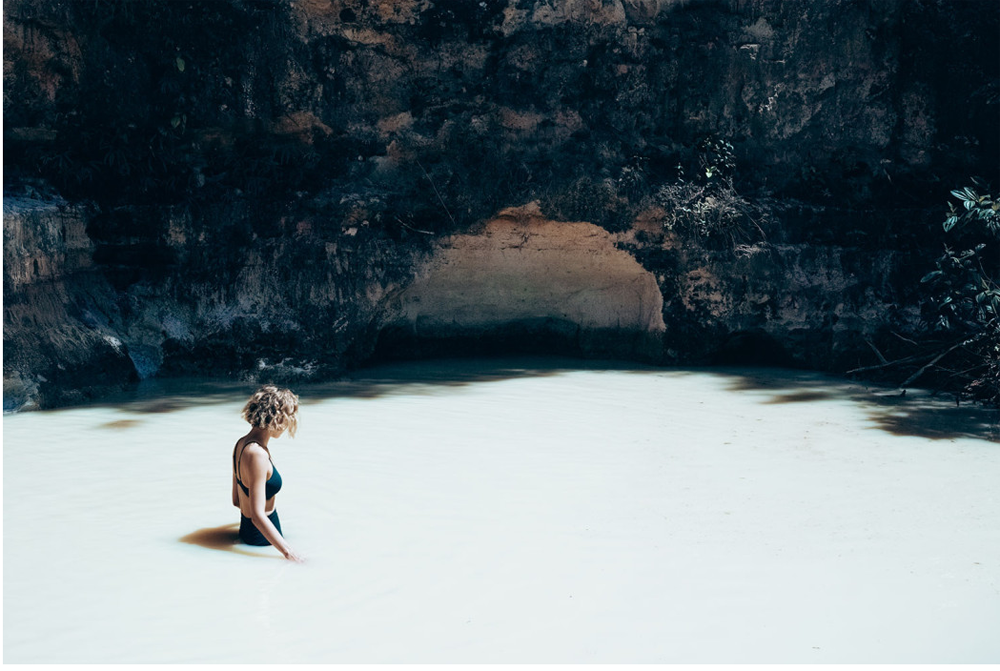
by Rebecca Taras | Feb 16, 2019 | Home, Spa Resorts, Spa Treatments, Spas
I worked in a five-star hotel spa for over four years, so I can tell you that the majority of my clients were there to receive a pampering experience. Don’t get me wrong, today’s savvy spa consumer wants results, too—but this type of guest is also willing to think outside the box and opt for a non-traditional service to further connect with their getaway destination of choice.
Of course, hotels and resorts all over the world are well aware of this, which is why service menus are tweaked to include indigenous ingredients and local area rituals and traditions to educate your mind and enlighten your spirit. Ahead, we present 10 spa treatments from around the world that will make you feel like a local in two hours or less.
Grand Garden Ritual: Grand Hotel Tremezzo
Destination: Italy
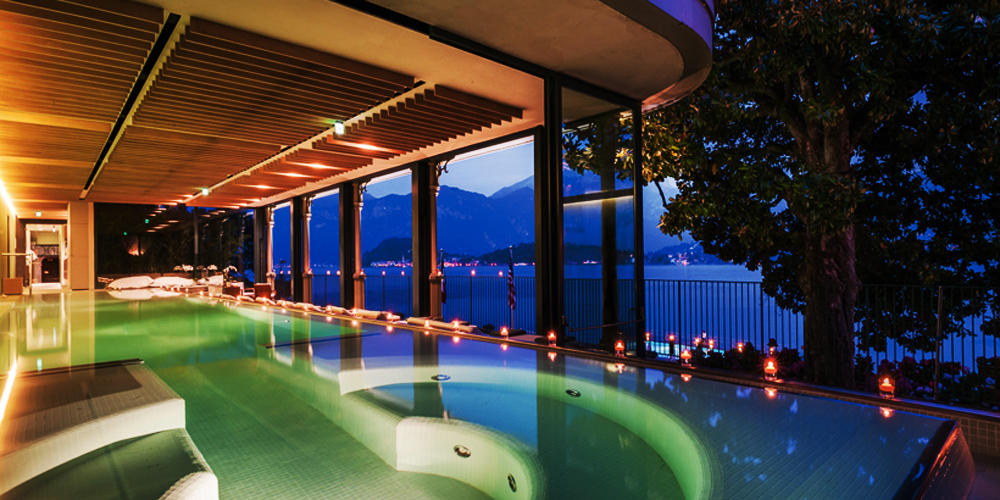
Photo courtesy of the Grand Hotel Tremezzo.
Between the crystal clear blue waters and villa-studded landscape, being in the Lake Como area is a treat in itself. But if you’re looking for a way to make your visit even more serene, the newly renovated T Spa at the stunning Grand Hotel Tremezzo hotel definitely caters to anyone seeking a little R&R—and a taste of the good life.
The Grand Garden Ritual ($270) is inspired by the fragrant flowers in the stunning Grand Hotel Tremezzo garden. The treatment begins with a welcome foot ritual and continues with a body exfoliation using natural sea salts and rosemary and lavender essential oils. Next, the guest receives a relaxing back massage and intensive facial treatment using the essence of neroli—talk about giving entirely new meaning to the term “garden fresh.”
Grand Hotel Tremezzo, Via Provinciale Regina 8, 22019 Tremezzina CO, Italy; +39 0344 42491.
Borinquen Coffee Polish: St. Regis Bahia Beach Resort
Destination: Puerto Rico
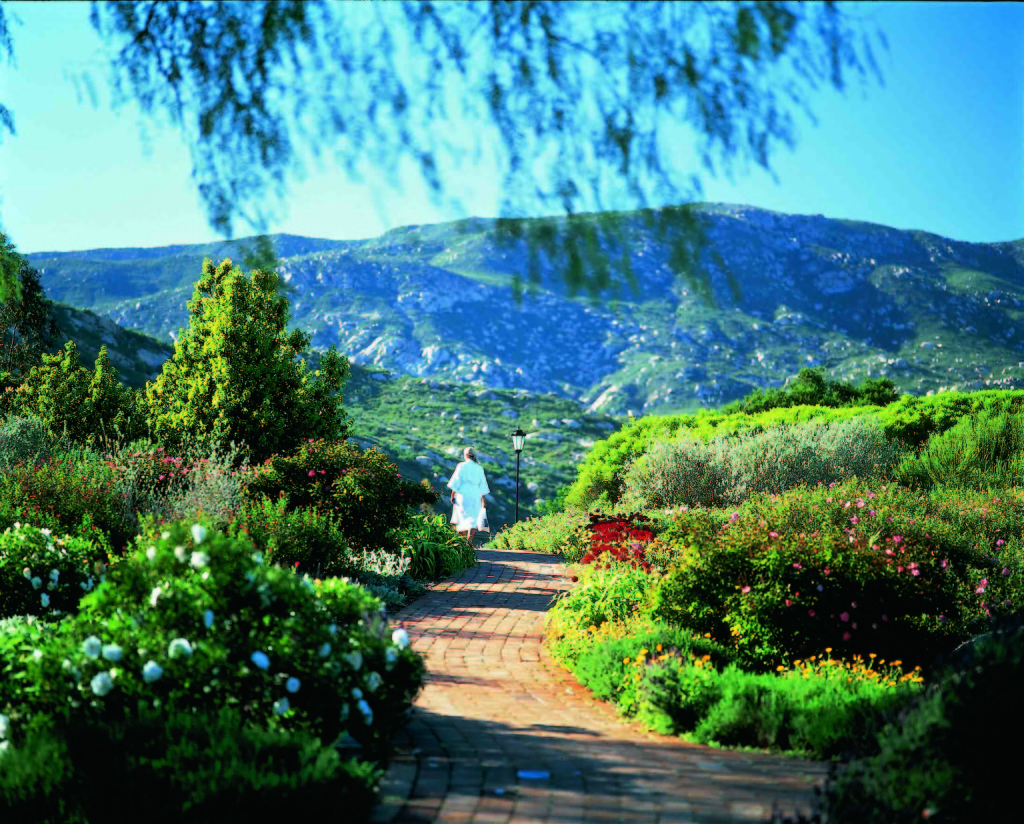
Photo courtesy of the St. Regis Bahia Beach Resort.
Located at the foot of the El Yunque National Rainforest is the resort’s 10,000 square foot Remède Spa, a luxurious retreat that beckons guests to become one with nature.
The Borinquen Coffee Polish ($170) treatment celebrates the fact that Puerto Rico is America’s leading coffee producer, harvesting 10-million pounds last year alone. The largest coffee and chocolate exhibition in the Caribbean takes place here in late September (26-27) to boot. Tying the two together, this indigenous polish awakens the skin and senses by incorporating coffee and cocoa butter to improve skin texture and increase circulation and skin firmness. The treatment is finished with a warm Vichy shower and an application of shea butter moisturizer to help repair cellular degeneration from time spent out on the beach.
St. Regis Bahia Beach Resort, State Road 187 Kilometer 4.2 (Rio Grande, Puerto Rico); 787-809-8000.
White Clay Treatment: UXUA Casa Hotel and Spa
Destination: Brazil
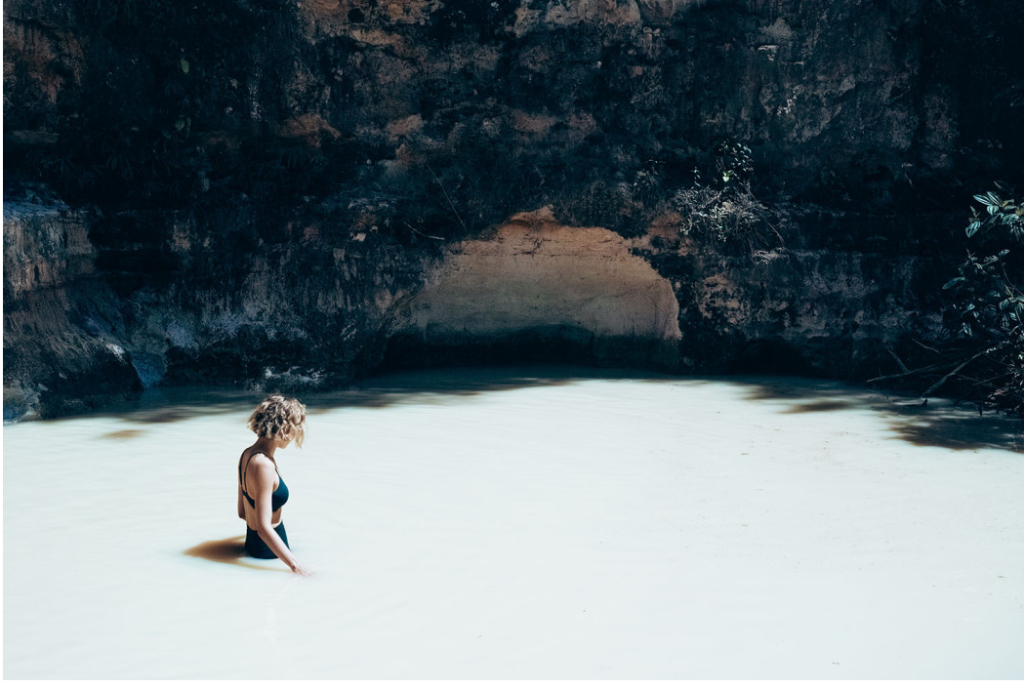
Photo courtesy of UXUA Casa Hotel and Spa.
From the moment you step into the stunning spa on the UXUA grounds, you’ll immediately get what it’s all about: pure and utter serenity. But aside from the lush, natural landscape, the most impressive aspect is its commitment to offering services that celebrate the heritage of the Pataxó Indians, African slaves, Jesuit missionaries and 20th century hippies who’ve roamed the land. The area’s vast biodiversity is also a focal point, so ingredients like almescar resin—indigenous to only southern Bahia and the Amazon—are used for their restorative qualities.
The White Clay Treatment ($350) stems from rituals performed by local tribes. To make the experience as authentic as possible, guests travel off-site via horseback or car to the red-colored cliffs of Taipe Beach, where they’ll cover themselves in a mineral-rich clay body scrub that’s been used for centuries as a natural form of stress relief therapy. After basking in the sun with their body covered in white clay, a quick dip in the ocean washes it all away, leaving skin fresh and smooth to the touch.
UXUA Casa Hotel and Spa (Quadrado Trancoso, Bahia Brazil); +55 73 3668 2277.
Traditional Hammam Treatment: Royal Mansour Spa
Destination: Morocco
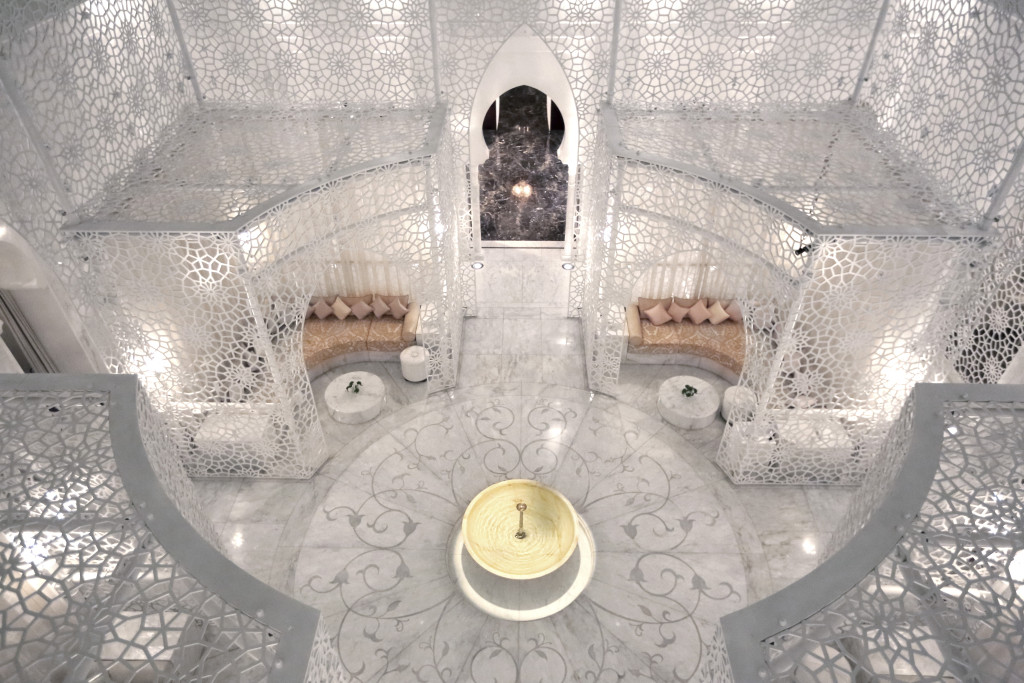
Photo courtesy of Royal Mansour.
If a picture says a thousand words, then you’re probably ready to book a ticket to Marrakesh by now. If your first thought was that the spa looks like a place fit for a king (or queen!), then you’re right on target—the Royal Mansour is actually owned by the King of Morocco.
The Traditional Hammam Treatment (approximately $121) is a Royal Mansour (and Moroccan) specialty, so it’s perfect for anyone looking to have both a pampering and cultural experience. The service begins with massaging a soap of olive resin to cleanse the skin and ease tension. Next, a detoxifying mask is applied, and the body is exfoliated with the traditional kessa massage glove. At this point, the body is warmed up, so it’s time to take a plunge in the cold room, resulting in a feeling of complete renewal.
Royal Mansour Marrakech, Rue Abou Abbas El Sebti (Marrakech, Morocco); + 212 5 29 80 80 80.
Zareeba Treatment: The Palms
Destination: Turks and Caicos
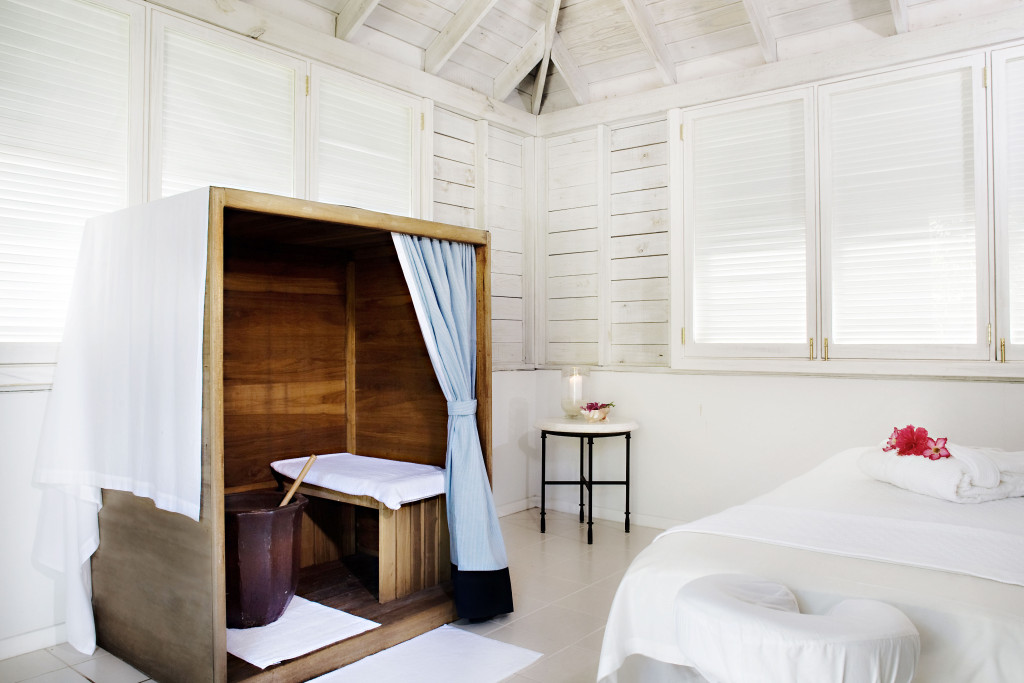
Photo courtesy of the Palms Turks and Caicos.
From holistic therapies to ancient remedies, this luxury resort on the famed Grace Bay Beach is home to an award-winning 25,000 square-foot spa that boasts all of the bells and whistles a beauty and wellness-enthusiast could ask for.
The Zareeba Treatment ($215) is one of many local-inspired services at The Palms—and it’s also a guest favorite. Zareeba literally means “protected enclosure,” so it’s no surprise that there’s a wrap involved. The experience begins with a full-body herbal cleansing and detoxification ritual using a Caribbean cure-all (dogwood, cerasee, rosemary, lemon, ginger, pimento, basil, eucalyptus, guaco bush, lemongrass, lignum vitae, pepper rod, and vervain) that’s been known to alleviate rashes, colds, fever, muscle pains, and nausea. Therapeutic herbs are inhaled with the help of steam before receiving a cooling wrap and a body massage to release toxins.
Try it at home:
- Draw a hot steamy bat
- Steep 4-6 of your favorite herbal tea bags in your bath and squeeze in 1 full lemon.
- Inhale the steam in deeply; as you lie there, try to focus on your own breath, and let your mind melt away…
The Palms Turks and Caicos, Grace Bay Beach, Princess Drive, Providenciales TKCA 1ZZ (Turks and Caicos Islands); 1-866-877-7256.
Ritual Xocoa Delicatessen: Majestic Hotel & Spa
Destination: Spain
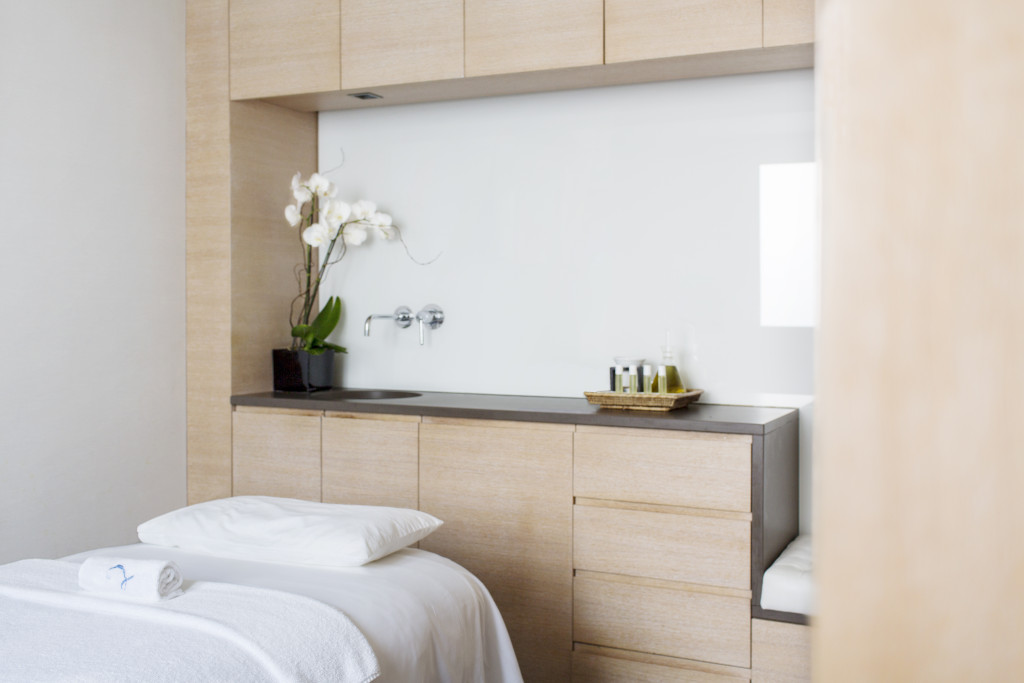
Photo courtesy of the Majestic Hotel Barcelona.
This sleek spa is a favorite of the international jet set—and with good reason. It’s a five-star respite in the heart of bustling Barcelona, complete with a list of top-notch services to match.
The Ritual Xocoa Delicatessen (approximately $177) is one of those services. The detoxifying (and calorie-free) massage pays homage to Spain’s part in the culinary history of chocolate, which dates all the way back to the 16th century—long before it was in the clutches of the Italians or the French. Along with receiving an extreme hydration boost, added benefits include the reduction of tension, stress and fatigue.
Majestic Hotel Barcelona, Passeig de Gràcia 68-70 (Barcelona, Spain); +34 93 488 17 17.
Honey Bliss Treatment: Twin Farms
Destination: Vermont
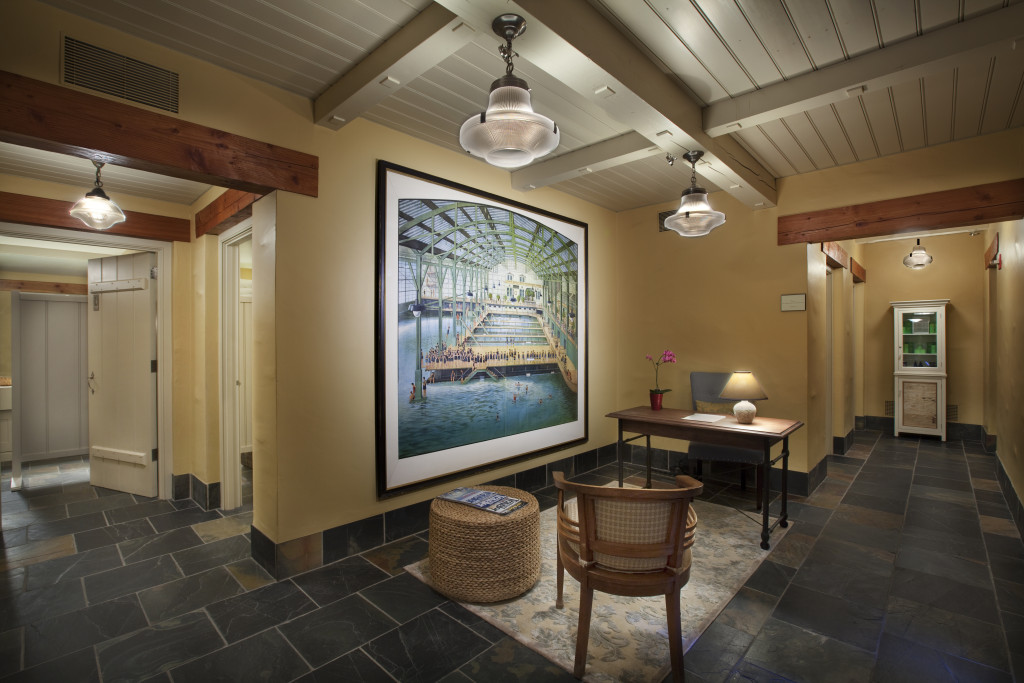
Photo courtesy of Twin Farms.
Forget what you think about Old McDonald. This is literally a five-star luxury farm experience spread out over 300 acres of beautiful landscape. The only laboring you have to worry on this farm is figuring out which spa services to receive.
The Honey Bliss Treatment ($230-$270) starts with a full-body exfoliation using a results-driven sugar scrub made with citrus essential oils and local honey to soften and renew the skin. After relaxing with a warm hydrating body masque and wrap, the massage therapist will execute a relaxing massage with shea butter for an added hydration boost. Add a facial enhancement for an additional $30.
Twin Farms, 452 Royalton Turnpike (Barnard, Vermont); 802-234-9999.
Fuller Brook Wild Crafted Wellness Experience: The Lodge at Glendorn
Destination: Pennsylvania
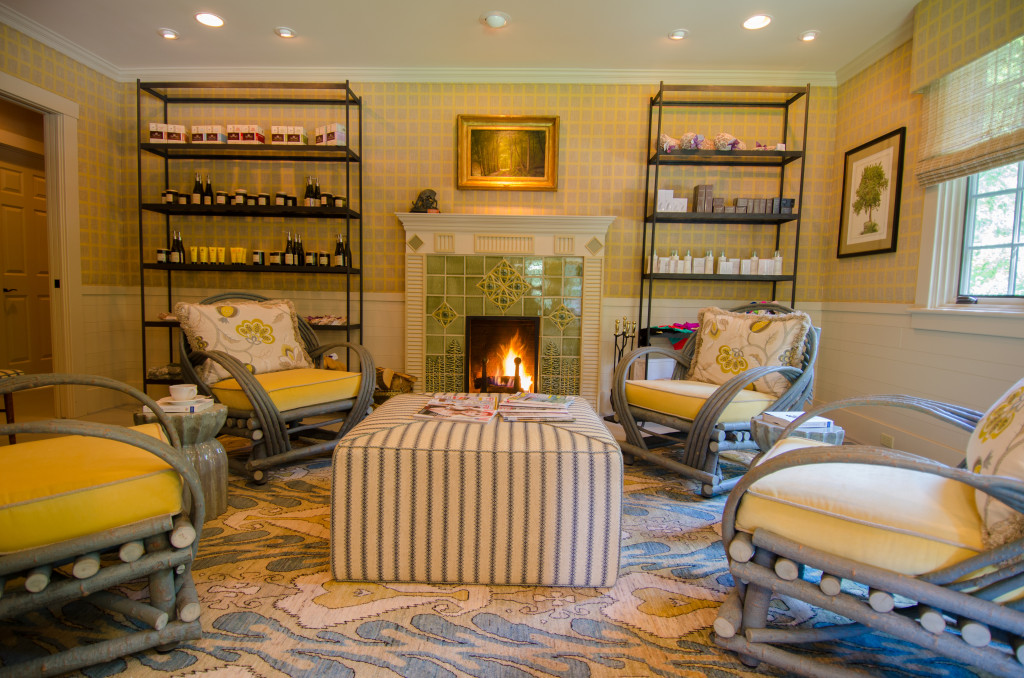
Photo courtesy of The Lodge at Glendorn.
This opulent-yet-intimate hideaway—a Relais & Chateaux property—is situated on 1,500 beautiful acres of land in Bradford, Pennsylvania. The lodge was originally a family vacation home owned by the Dorn family from 1927 to 1995. It was up for auction in 2009, but a man by the name of Cliff Forrest stepped in and restored the property to its glorious state. While a bevvy of outdoor activities are within close reach, the lodge debuted an intimate spa in 2014 for those seeking a little indoor R&R.
The Fuller Brook Wild Crafted Wellness Experience ($135 to-go, $250 to have the product applied at the spa during your treatment) gives guests the unique opportunity to work with the “spa chef” to forage ingredients from throughout the property to create everything your very own product, such as a lavender scrub with lemon balm and rose water. The entire process, sans treatment, takes about an hour.
The Lodge at Glendorn, 1000 Glendorn Drive (Bradford, Pennsylvania); 814-362-6511.
Voodoo Massage: The Ritz-Carlton New Orleans
Destination: Louisiana

Photo courtesy of the Ritz-Carlton New Orleans.
It doesn’t have to be Mardi Gras for New Orleans to be pulsating with energy. And after a day of eating, sipping on hurricanes, and listening to jazz throughout the streets of the French Quarter, pop into this award-winning spa for a service with a unique take on the history of the Big Easy.
The Voodoo Massage ($150-$220) The soul of New Orleans is magical and mystical, and this massage — using oil with notes of absinthe, bourbon, cypress, moss, and vetiver — will put you under a spell of complete relaxation. Incense permeates the room, and voodoo chants set the ambiance like no other therapy you’ve ever experienced.
The Ritz-Carlton New Orleans, 921 Canal Street (New Orleans, Louisiana); 504-524-1331.
RLP Herbal Wrap: Rancho La Puerta
Destination: Mexico
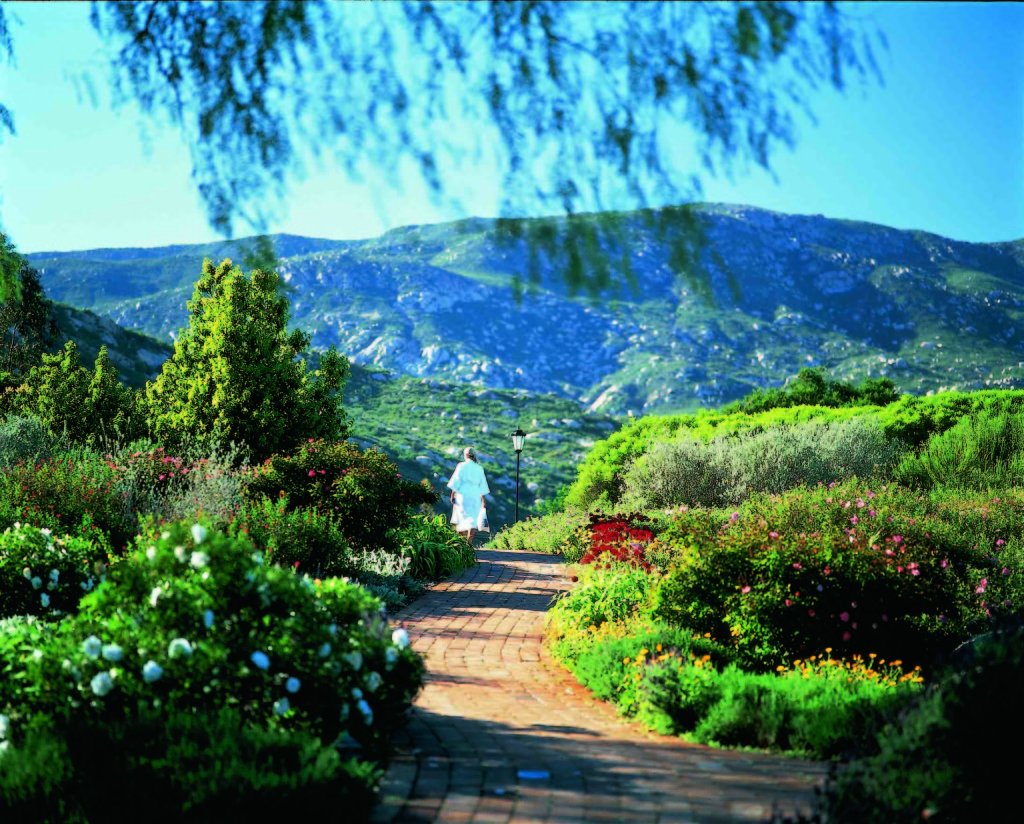
Photo courtesy of Rancho La Pureta.
When contemplating your next destination spa getaway, keep this in mind: Rancho La Puerta was named the number-one destination spa in the World by Travel + Leisure’s 2014 World’s Best Awards—and the three years before that. The 3,000-acre property is the original “fitness resort,” so guests can expect a wide array of activities to suit all interests and levels of athleticism. Of course, the resort isn’t all work and no play. The spa makes it a priority to guide guests through a series of cleansing, relaxing, energizing, and restorative treatments throughout their stay.
The RLP Herbal Wrap ($50) incorporates indigenous ingredients (California sagebrush, powis castle, rosemary, white sage, and eucalyptus) that were harvested right before treatment. The cocoon-like treatment warms, cleanses, moisturizes, and nourishes the skin, while steaming hot linens steeped in traditional, local Native American herbs wrap the body in aromatic bliss.
Rancho La Puerta, Carretera Tecate-Tijuana Kilometer 136.5 (Tecate, Mexico); 800-443-7565.
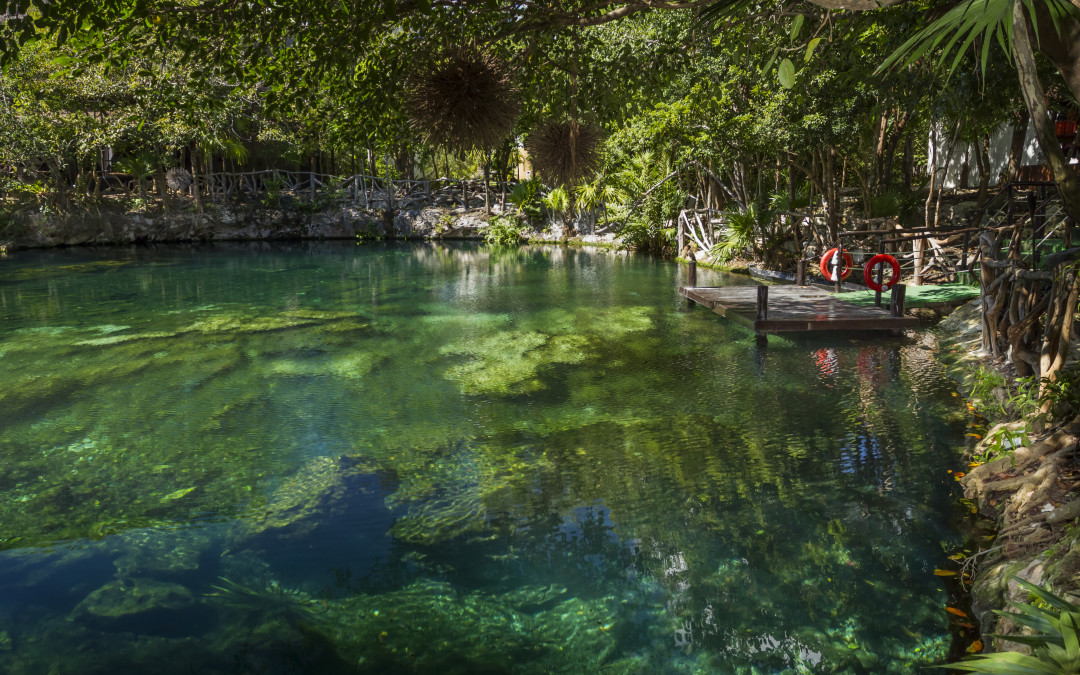
by Rebecca Taras | Feb 15, 2019 | Home, Resorts, Wellness Retreats, Yoga, Yoga Retreats
While one of the most obvious (and immediate) benefits of yoga is stress relief, there’s no denying that it can sometimes be challenging to find your Zen in a cramped city or strip mall studio illuminated by battery-operated candles. With that said, it’s no surprise that consumers spend $27 billion dollars on yoga retreats each year. And, why not? According to a recent study published by the Society for Chaos Theory (seriously — check it out), it’s been proven that a change of scenery, and spending time outdoors, is shown to boost moods and improve mental well-being.
Now, you probably didn’t need a study to prove that taking a vacation has a positive effect on the spirit, but it sure does help to have a few legitimate statistics in the back of your mind every time you feel guilty about submitting a time-off request. So, to inspire you on your next journey to inner peace, here are seven amazing yoga retreats that are guaranteed to center even the most off-balanced yogi.
Atlantic Ocean Cliff: The W Retreat & Spa
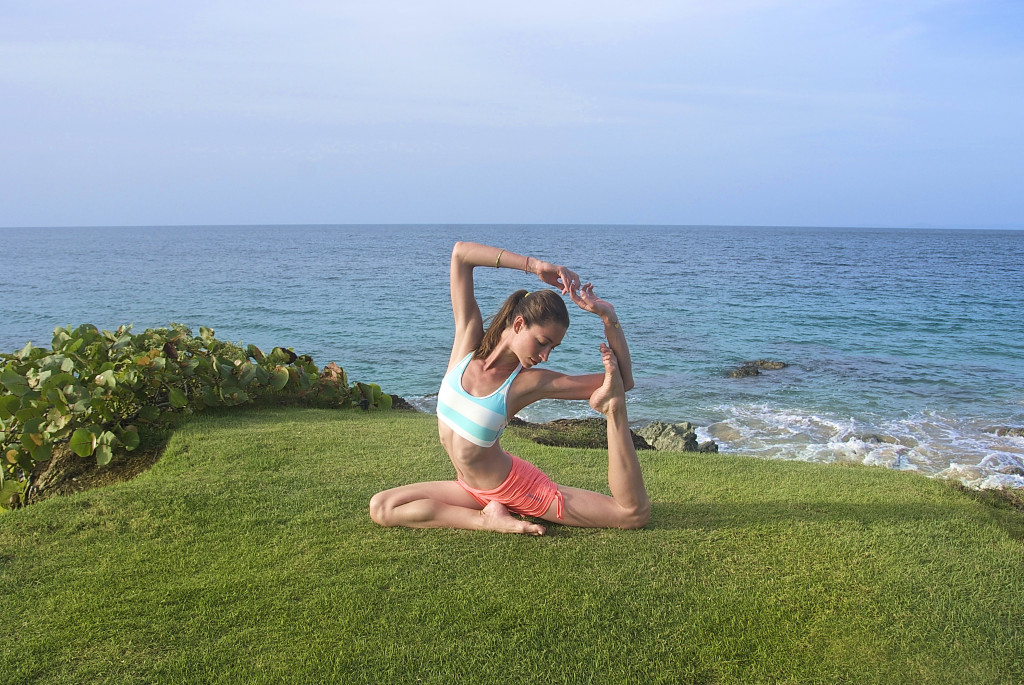
Photo courtesy of The W Retreat & Spa on Vieques Island.
Located just eight short miles off the coast of Puerto Rico, this stunning retreat on Vieques Island—listed as one of the best hotels in the world by Travel & Leisure—is easily accessible via a 20-minute flight from San Juan International Airport. The property recently launched a new three- or five-day program created by Tara Stiles, an American model-turned-yoga-instructor and founder of Strala Yoga in New York City. The ENERGIZE retreat includes twice-daily yoga sessions on Paradise Edge-cliff, overlooking the Atlantic Ocean, at sunrise and sunset; nature escapes; made-to-order spa treatments; and cooking classes.
The W Retreat & Spa on Vieques Island, State Road 200 KM 3.2 (Vieques Island, Puerto Rico); 787-741-4100.
Manhattan Cruise: Spirit of New York Yoga on the Water Cruise
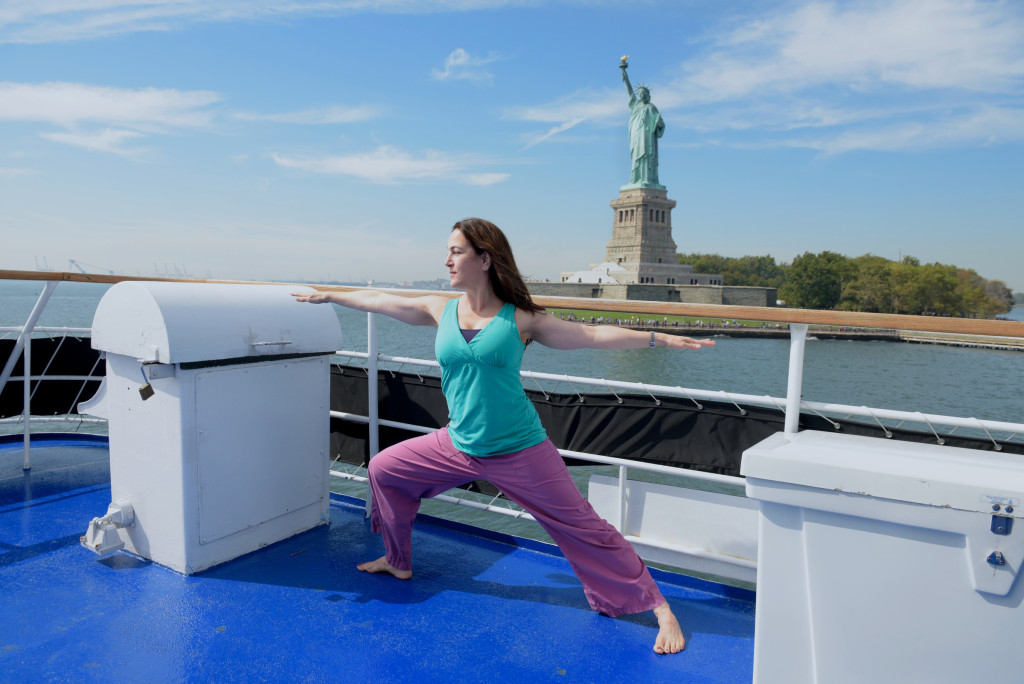
This specialty lunch cruise (starting at $51.90 per person) from Spirit of New York is perfect for those looking for a serious lunch break. The two-hour jaunt includes a 45-minute yoga class, taught by Rae Broderick from Strala yoga studio, complimentary yoga mats and gift bags (provided by Athleta); and a light lunch consisting of healthy fare such as a spinach and kale salad and roasted tilapia.
Spirit of New York at Chelsea Piers, 62 Chelsea Piers (New York, New York); 866-483-3866.
Mayan Jungle: Sandos Caracol Eco Experience Resort

Photo courtesy of Sandos Caracol.
This eco resort provides guests with the opportunity to fall off the grid without giving up any of life’s little luxuries. The complimentary yoga classes within the lush environs of the Mayan Jungle are among the laundry list of top-notch activities available at this all-inclusive paradise.
Sandos Caracol Eco Experience Resort, Carretera Puerto Juarez-Chetumal Km. 295 (Playa Del Carmen, Mexico); +52 984 873 4444.
Hawaiian Mountains and Ocean: Hilton Hawaiian Village

Photo courtesy of Hilton Hawaiian Village.
Boasting stunning views of the Pacific Ocean and Diamond Head Crater, Waikiki’s only beachfront resort features a multitude of outdoor yoga activities. Guests can try their hand at SUP (stand-up paddle board) yoga at the world-famous Duke Kahanamoku Lagoon, named after Hawaii’s legendary Ambassador of Aloha: surfer and Olympic swimming champion Duke Kahanamoku.
Hilton Hawaiian Village, 2005 Kalia Road (Honolulu, Hawaii); 808-949-4321.
Farmscape: Finger Lakes Cider House

Photo courtesy of Allison Usavage.
Looking for a truly unique yoga experience? At the beginning of each season, FLCH hosts a single yoga session that incorporates a somatic exercise to connect participants with the unique seasonal rhythms of the farm, as well as their asana practice. The workshop is designed to explore the connection between the body-mind and the farm’s ecology.
Finger Lakes Cider House, 4017 Hickok Road (Interlaken, New York); 607-351-3313.
Miami Oceanfront: Acqualina Resort & Spa
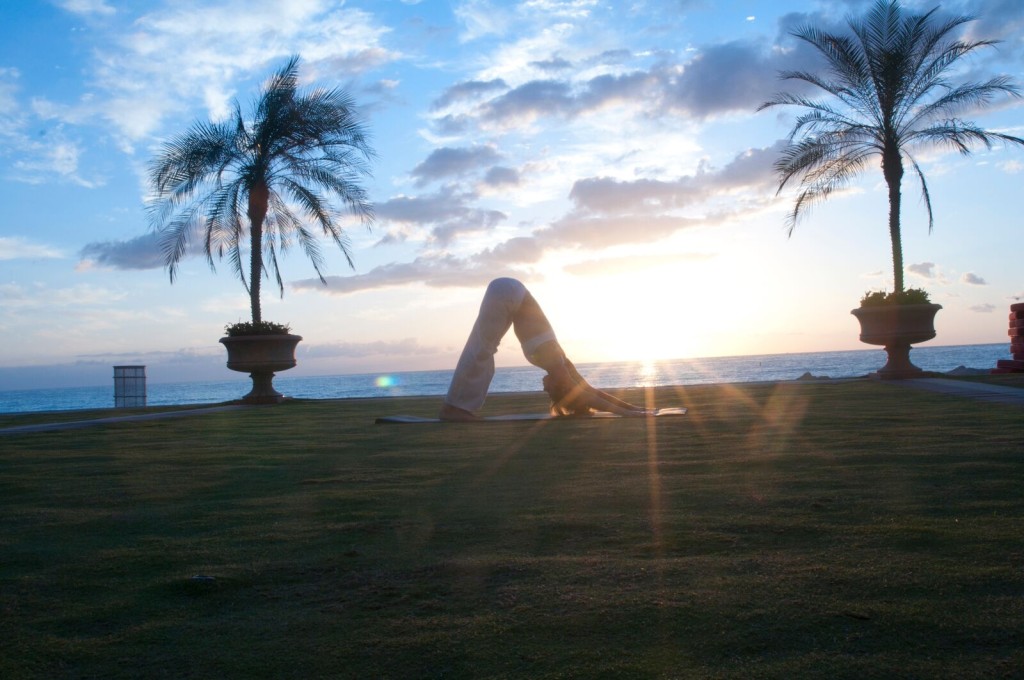
Photo courtesy of Acqualina Resort & Spa.
This shiny Miami jewel has a yoga program to live up to the hotel’s five-star status. YOGiiZa’s team of seasoned yoginis and wellness gurus provide a wide array of personalized programs, including yoga sessions and health and wellness coaching, against the backdrop of the Atlantic Ocean.
Acqualina Resort & Spa, 17875 Collins Avenue (Sunny Isles Beach, Florida); 305-918-8000.
Marina Views: Montauk Yacht Club Resort & Marina
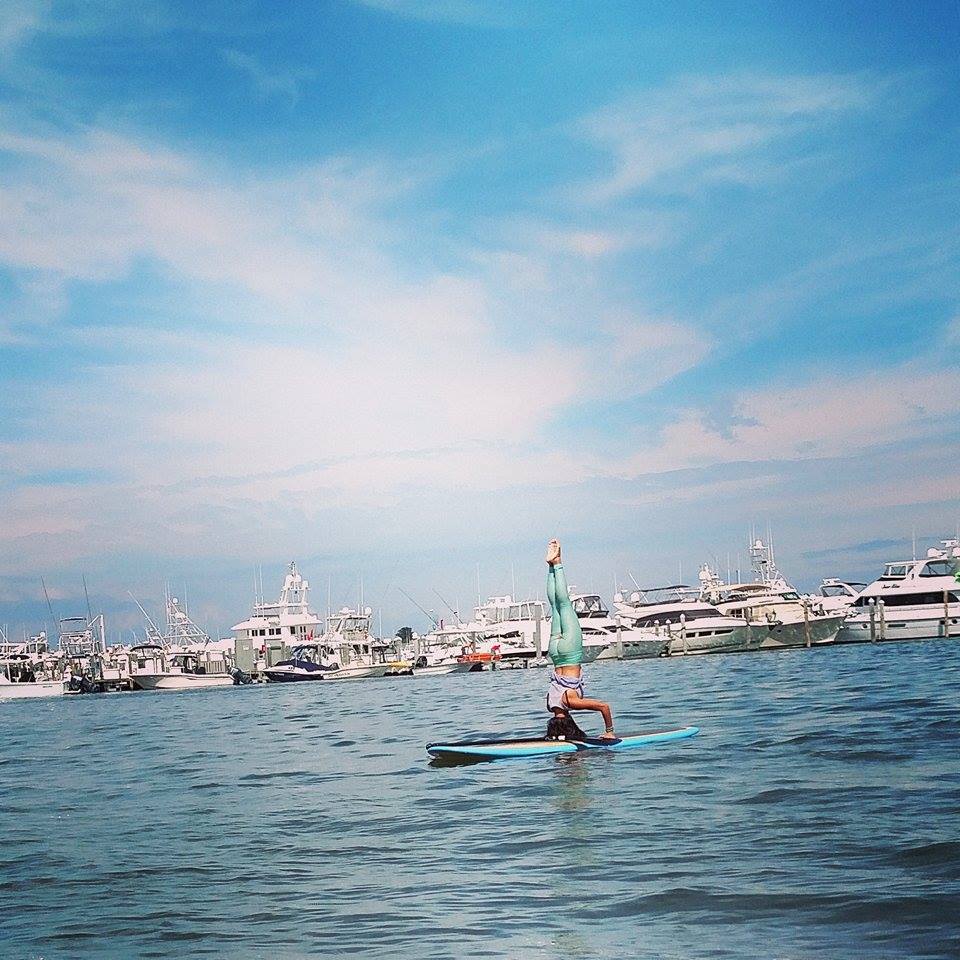
Photo courtesy of Montauk Yacht Club.
Along with a multitude of water sports, private yacht cruises and fishing excursions, this historic Hamptons hideaway offers beachside and on-water yoga with the breathtaking marina as the backdrop. Yoga mats, props and a complimentary Zico Coconut Water are provided to all participants.
Montauk Yacht Club Resort & Marina, 32 Star Island Road (Montauk, New York); 631-668-3100.
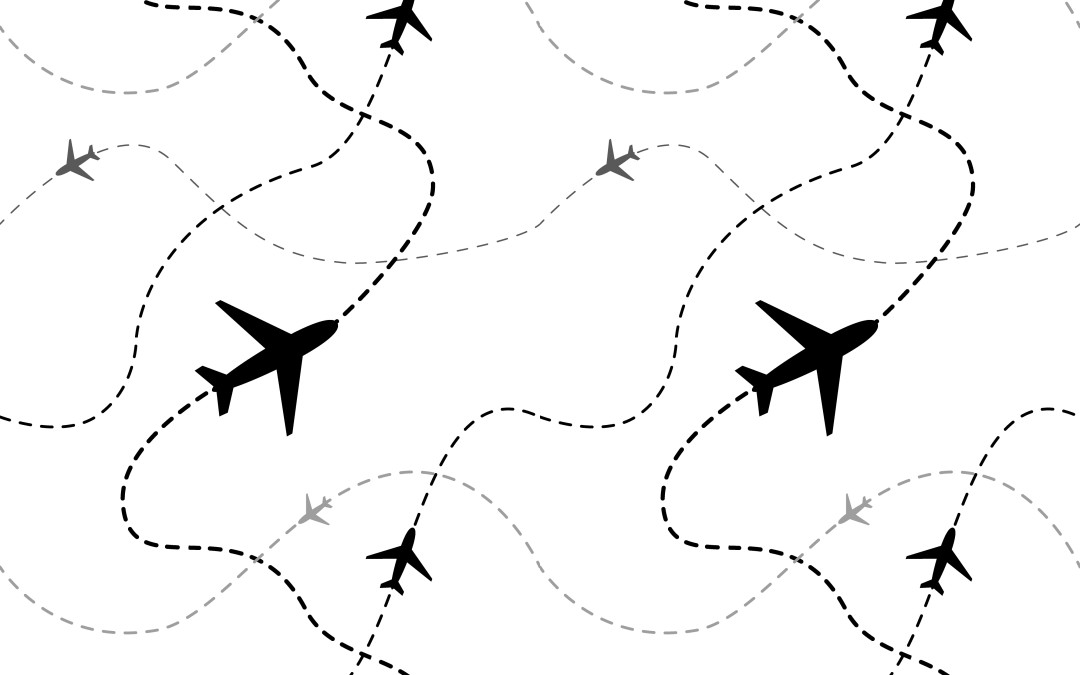
by Rebecca Taras | Feb 11, 2019 | Flying, Home
Fear of flying? You’re not alone. But the reality is, all the Xanax, meditation music, aromatherapy, and in-flight cocktails in the world are only going to mask your problem, not solve it. That’s where FlyHome comes in. The savvy service offers online courses (ranging from $99 to $795 depending on the duration) that cover everything from the physics behind a flying plane to how pilots avoid collision to those ominous sounds that you immediately translate as trouble.
The programs—designed and taught by experienced pilots—are geared toward business and leisure travelers alike, so you’re covered regardless of the frequency or the distance. Truthfully, I don’t have a regular fear of flying, but there are definitely times when I feel a bit unsettled (who doesn’t?), and I’ve definitely either sat next to or traveled with someone who wouldn’t be comfortable until wheels are down. So after chatting with Captain Tim Griffin, I gained a better understanding of the technical specifics that support any fear in the book.
When did FlyHome officially launch?
“FlyHome officially launched in 2013, after I worked one-on-one with a series of test groups.”
Tell me a little bit about the FlyHome team? How did the group of pilots get involved?
“Many of the pilots of FlyHome are actually one family, ranging from my grandfather, who was a Pan American Captain, to my Aunt, who was the first Female pilot for Pan American. Other members of the team are pilots that I met throughout my career who have an extensive background in aviation.”
What’s the difference between the vacation and business traveler packages, and why are these two categorized differently?
“The difference between the Vacation Traveler Course and the Business Traveler Course is not just the number of sessions; however, the business traveler course offers more ‘Pre-Flight Briefings,’ which is when the client will speak with their instructor on the day of their flight to discuss weather, routing, airline, aircraft type, and, most importantly, turbulence locations. Since Business Travelers fly more often, increasing the number of pre-flight briefings was a great incentive for them to use.”
Do you happen to notice that your business increases/peaks depending on the news, what’s happening in the world—e.g., ISIS, etc.?
“Activity does, in fact, increase when there is more media exposure on commercial aviation events.”
What are the biggest questions and concerns you receive, and what are some tips you offer to get through these situations?
“Hands down, turbulence is the biggest fear. Most clients feel as if they’re dropping hundreds, or even thousands, of feet while flying in turbulence, so we take them behind the scenes via video footage from the cockpit to show what the plane is actually doing—and it is nowhere near where you think it would be (for the better!). From wing design to pilot activity, we prove how the effects of turbulence can be minimized.”
“The second most popular questions are the ‘what if?’ scenarios that occur either before or during the flight. ‘What if the engine fails?’ ‘What if the pilot has a heart attack?’ ‘What if the electrical system fails?’ While these are just a few examples, the Pilots at FlyHome teach clients the training that they receive as well as about the systems that are in place on board to prevent total failures.”
The average consumer can’t afford to fly first class, but there are a lot of claustrophobic people out there. How can this flyer get through—especially if that end seat isn’t available?
“Open that window shade and the air vents; tell the flight attendants you’re anxious; get up and stretch out when the ‘fasten seatbelt’ light is off—little things can make a plane feel more comfortable!”
When we’re stuck on the tarmac for “technical issues,” what’s generally going on? Personally, I’m terrified that there’s anything from a gas leak to a broken wing!
“The truth of the matter is, when flying on the airlines, the FAA strictly regulates everything—which is good! However, when something isn’t working, even if it is a small and not-so-essential item, many things have to be done to receive clearance to take off with an inoperative item. However, if it is a larger item, then a mechanic might have to come on board to replace or repair it. After that is done, it will need to be signed off on before the plane can depart— this can be very time consuming.”
“There is a book for every plane, called an MEL (Minimum Equipment List), which will tell you what needs to be operative; what can be inoperative to fly with; and, if it can be flown with ‘inoperative,’ what measures have to be met to do so. We worked with a client who was delayed for three hours because of a broken tray table. It doesn’t seem so big, but believe it or not, it had to be fixed before takeoff was allowed.”
How does the purchaser know that they are “ready to fly” after taking one of your programs?
“Many clients actually enroll in the course to give them the courage to book the ticket—when they are at that point, the motivation will be there to get on board. The pre-flight briefings are great because the client becomes very comfortable with their assigned instructor/pilot—being able to talk with them beforehand is a huge hit.”
What are the top items every fearful flyer should carry in his/her onboard bag?
“An iPad, iPhone, computer, headphones, book—whatever will distract them from their personal fear.”
Fore more information, visit FlyHome or My Flight Forecast.
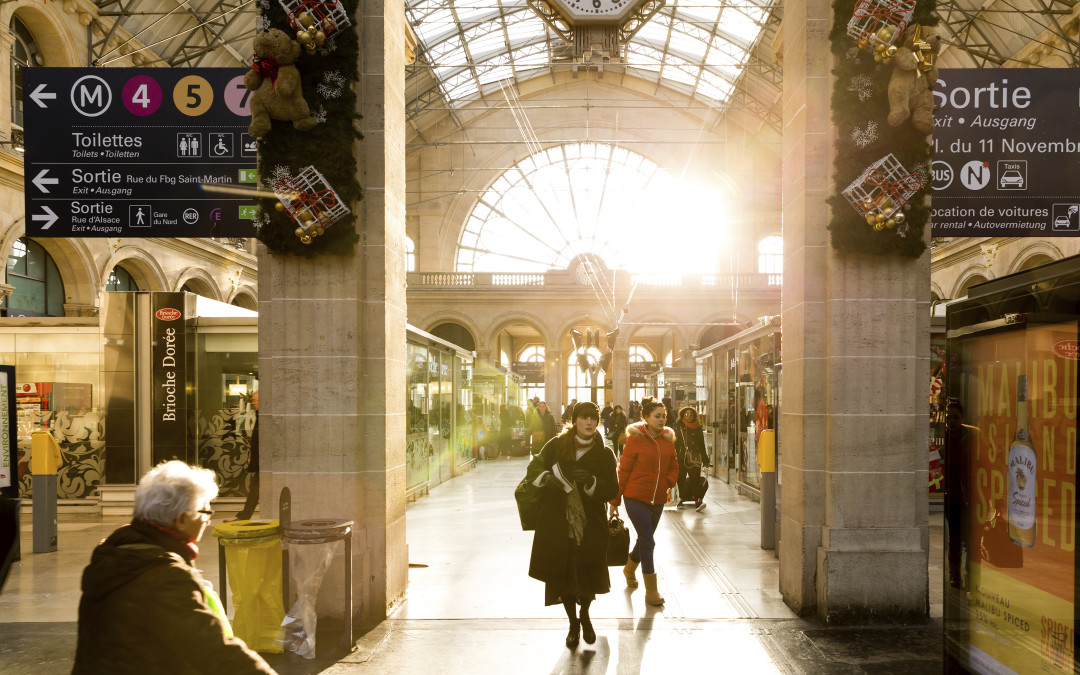
by Rebecca Taras | Feb 10, 2019 | Food, Home, Paris, Profiles, Recipes
While you may have traveled to the same destination as your friends, family or social circle, it is our individual experiences that shape us, inspire us and leave an impression that cannot be replicated through someone else’s eyes. It’s an impact that lasts longer than any photograph or social media post every could.
For former actress Vikki Krinsky, who starred in shows such as Wild Card and Edgemont, travel meant change. Distraught with the pressures of staying thin in Hollywood, Krinksy booked a one-way ticket to Europe, where she ultimately shaped her newfound career as a successful private chef in Los Angeles for several well-known actors and Hollywood personalities. When you hear how she got her start (hint: a fated meeting on a train to Paris), you’re going to want to book your next vacation, stat.
Ahead, Krinsky shares her her career journey, go-to travel spots, and a recipe makeover (she’s a host on Recipe Rehab) for one of her favorite ethnic dishes from a previous vacation. How will your next trip inspire you?
Tell us a little bit about your time as an actress. How did the pressures to stay thin inspire you to make a career change?
“The truth is, I loved acting. I loved being a part of an ensemble and developing a character that wasn’t me. I loved expressing myself and creating something for girls around the world to relate to. The fan mail was like nothing I had ever experienced before. At a very young age I learned how people connect to actors, so I was grateful to have been given that powerful platform.”
“However, with my success came pressure. The pressure to look a certain way and maintain a certain weight started to affect the way I felt daily. It made me irritable and lowered my self-confidence. As a natural leader, I felt as though I was losing my footing and what mattered most.”
When did you decide to quit and make the decision to book a one-way ticket to Europe?
“I moved to Los Angeles when I was 19 while on hiatus from the second season of the Lifetime show Zoe Busiek’s Wild Card. I flew down to audition for a Disney gymnastics movie called Stick It. I tested for a couple of shows and didn’t land any roles. Basically, I was told to ‘lose five pounds and look into vaneers’ by several ‘important’ people such as agents, managers and producers. After hitting an all-time-low, I decided to take a break from acting. I was completely discouraged by my negative body image and the pressure to be thin. I thought it was a good time to explore, live the life of a backpacker and take off to Europe!”
“Alongside sweat pants and T-shirts, I brought my nutritional books, and off I went. Paris was first on my list. There I was on the train, second day in, coincidentally sitting next to a chef from a very upscale hotel restaurant. He noticed my book, and we started chatting. Next thing I know, I was in his kitchen learning how to make the famous Tarte Tatin. I loved every minute of that experience. He was kind enough to connect me to chefs all over Europe—Amsterdam, Milan, Switzerland and London. After a little over five months of backpacking and lightly ‘staging’ in a few kitchens, I came back to Los Angeles with a new zest for food, health and cooking!”
So, you never formally went to culinary school?
“I didn’t! Happily self-taught.”
What were some of the most valuable techniques/lessons you learned during this period in your life?
“Outside of basic knife skills and chopping techniques, I learned it was extremely important to maintain a clean and tidy work area. This has been a huge lesson as a private chef. Working in celebrity homes, it’s crucial to clean as I go. Keeping everything neat and organized has helped secure my place as a reputable private chef. I also learned that ‘scraps’ should be saved for stock, sauces and dressings. Nothing goes to waste.”
When did the health-kick passion come into the mix?
“Playing competitive sports my whole life has driven me to be as fit and healthy as possible. However, it became a slight obsession after being told, several times, to lose weight. I didn’t like how I started to view food. It was unhealthy and made me unhappy. I knew at a young age I needed to turn this mentality around, and that’s when I started studying and researching nutrition and sports medicine. I recognized people wanted delicious fine-dining meals, and my passion became creating those with a nutritional twist.”
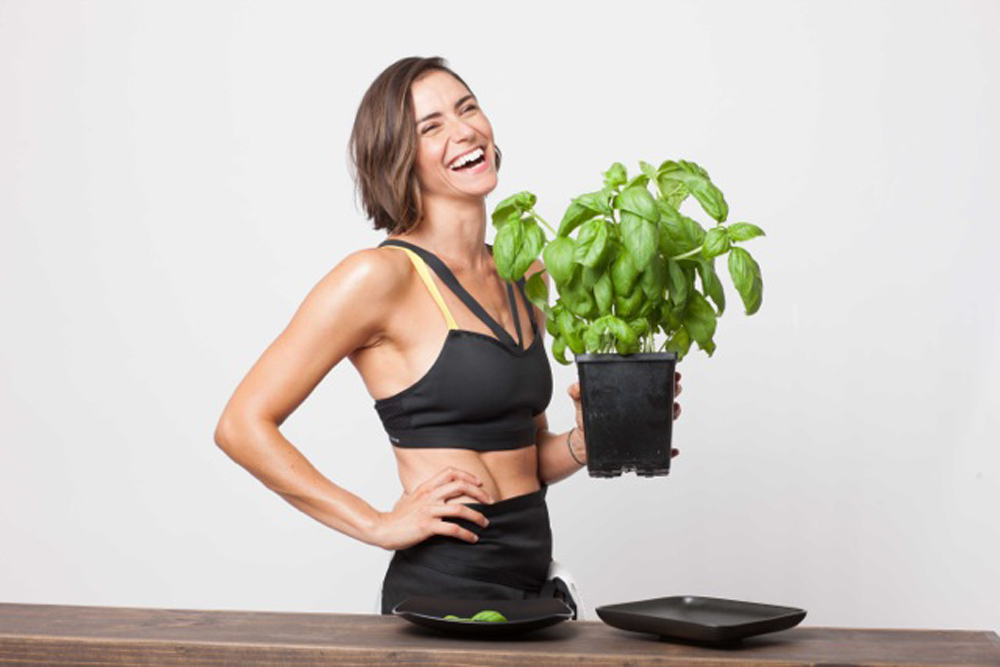
What are a couple of your most memorable dining experiences?
Blue Hill in Tarrytown, New York: “From the moment you enter the farm to the moment you leave you feel as though you’ve entered a magical dream! All of your senses are stimulated, and the primary focus on ‘farm-to-table’ is expressed throughout the entire experience.”
Lapérouse in Paris, France: “Incredibly elegant and romantic. This was the first restaurant I witnessed a decadent soufflé finished off with a pour of hot chocolate ganache — by an ever-so-handsome and professional waiter. I recognized here that service was just as important as the meal itself.”
If someone wanted to go on an epicurean/foodie vacation of their dreams, what places would you steer them to and why?
“Aside from the obvious — Italy, France and Spain — my top three places to travel solely for their food would be:
Chicago: “The Windy City has an amazing array of terrific street food and fine dining, providing a great balance.”
New York: “I eat everything while I’m there! From street pupusas to dirty-water-dogs (hot dogs) on the bustling corners of Manhattan. I leave my evenings free for anything from Barbuto or ABC Kitchen to fine dining restaurants like Le Bernardin or Eleven Madison Park.”
Israel: “Spectacular ingredients and extremely talented chefs. Israeli cuisine continues to adapt elements of various styles of cuisine. Mediterranean ingredients, as well as Sephardic and Ashkenazi styles of Jewish cooking, influence it, so it’s very flavorful and healthy.”
What tips can you offer for staying in shape while traveling, without having to give up experiencing all the amazing local cuisine?
“Keeping hydrated is incredibly important while traveling. Time change and imbalanced blood sugar levels can make you feel hungry when you’re actually dehydrated. It’s important to be sure to nibble on small amounts of high-protein, low-sugar snacks, like unsalted nuts or 85% or higher dark chocolate, every two to three hours. Also, taking advantage of active means of transportation—like riding a bicycle or walking as much as possible—is a great way to explore while burning a few extra calories.”
Recipe makeover challenge: One of the best ethnic dishes that you had on your travels.
“I had an incredible traditional tamale while in Mexico, so I decided to create a healthy ‘Krinskified’ version! Remember, portion control is your friend.”
MUFFIN TIN TAMALES
“There’s nothing like the flavors of a traditional, warm gooey, tamale, made with fresh ingredients, bursting with flavor, and all-ready to eat in a healthy portion-size cup!

Serves: 4
Cook time: 40-minutes
Prep time: 15-minutes
CRUST:
4 teaspoons coconut oil
1 1/2 cups masa (Note: Masa or masa harina (or corn flour) is a very finely ground cornmeal.)
2 cups low-sodium, fat-free chicken stock
½ teaspoon baking powder (aluminum free)
pinch of salt and pepper
FILLING:
1 tablespoon coconut oil
1 pound extra lean ground turkey
1 medium yellow onion, small dice (about 1 cup)
3 medium garlic cloves, fine chop
3 tablespoons apple cider vinegar
1 teaspoon paprika
1 teaspoon oregano
1 teaspoon cumin
Pinch of cayenne pepper
1 15 oz. can diced fire roasted tomatoes
½ cup low-sodium fat free chicken broth
½ teaspoon salt
½ teaspoon fresh ground pepper
TOPPING:
1/3 cup low fat mozzarella cheese
½ cup plain fat free Greek yogurt
¼ cup chopped cilantro
STEPS:
- Heat the oven to 375 degrees with a rack in the middle.
- Place coconut oil, masa, chicken stock, baking powder, salt and pepper in a medium bowl and mix well with a spatula until combined and soft. Cover the bowl with plastic wrap and set aside.
- Heat the coconut oil in a large pan over medium-high heat. Add the turkey, salt and pepper, and break the meat into small pieces with a wooden spoon. Stir occasionally until browned and cooked through, about four minutes. Remove the turkey with a slotted spoon to a medium bowl and set aside.
- Reduce the heat to medium and add the onion and garlic. Cook, stirring occasionally, until the onion softens, about four-minutes.
Add the vinegar and stir to combine, scraping up any browned bits from the bottom of the pan. Sprinkle in the paprika, oregano, cumin, and cayenne, and stir until incorporated. Cook for about two-minutes.
- Add the turkey, tomatoes, chicken broth, salt, and pepper to the pan—stir to combine. Cook for another three-minutes.
- Reduce the heat to low and simmer, stirring occasionally, until the sauce thickens slightly, about five-to-seven-minutes more. Remove the pan from the heat. Taste, and add a touch more salt, pepper, and cayenne if you see fit!
- Using the muffin tin base, spray four-inch foil cups really well with olive oil spray. Take about a teaspoon of masa and spread a thin layer evenly in the cups and up the sides, being careful it’s not too thick. Add two teaspoons of the turkey mixture to the middle of the muffin tin cup. Cover the entire pan with tinfoil and bake for 20-minutes.
- Carefully remove the tamales from the oven and sprinkle with cheese. Place back in the oven uncovered for 10-minutes. Gently run a knife around the edges and carefully flip tin cups upside down. Top with a dollop of fat-free Greek yogurt and a sprinkle of fresh cilantro!
Nutritional information (per serving):
Calories: 390
Fat calories: 100
Total fat grams: 11
Sat fat grams: 7
Cholesterol mg: 65
Sodium mg: 970
Total carbohydrates g: 39
Fiber g: 4
Sugars g: 4
Protein g: 35









































